🙌 Awesome, you're subscribed!
Thanks for subscribing! Look out for your first newsletter in your inbox soon!
Get us in your inbox
Sign up to our newsletter for the latest and greatest from your city and beyond
By entering your email address you agree to our Terms of Use and Privacy Policy and consent to receive emails from Time Out about news, events, offers and partner promotions.
Awesome, you're subscribed!
The best things in life are free.
Sign up for our email to enjoy your city without spending a thing (as well as some options when you’re feeling flush).
Déjà vu! We already have this email. Try another?
Love the mag?
Our newsletter hand-delivers the best bits to your inbox. Sign up to unlock our digital magazines and also receive the latest news, events, offers and partner promotions.
- Things to Do
- Food & Drink
- Arts & Culture
- Time Out Market
- Coca-Cola Foodmarks
- Los Angeles


The travel destinations that want tourists to stay away
Mass tourism is back, but these spots are fighting against the rising tide. These are the destinations that want tourists to stay away in 2023

Remember when everyone thought the pandemic would usher in a new tourism of awareness and restraint? Yeah, those days are long gone. Mass tourism has returned with a vengeance. Images of empty streets in the world’s most popular cities have been replaced by those that became the norm pre-2020 – namely crowds of tourists looking for famous attractions, restaurants and shops. But not all destinations are taking this lying down. Some of the world’s most popular tourist destinations are fighting back, whether by implementing increased tourist taxes or restrictions on the number of visitors allowed. Some are flat-out telling tourists not to come. These are the destinations that want tourists to stay away in 2023.
RECOMMENDED: 🗺 The world’s most underrated travel destinations 🌍 The countries that need more travellers 🛤 12 ways to be a better tourist 🧭 Why you should travel somewhere new this year
Been there, done that? Think again, my friend.
The destinations that want tourists to stay away
1. amsterdam.

Amsterdam ’s reputation as an anything-goes hub of hedonism is well known, and the Dutch capital has become as synonymous with bad behaviour as it has gorgeous architecture and a history of innovation. For some, what happens in the ‘Dam, stays in the ‘Dam, but those days might be on the way out. The city’s 2023 ad campaign was blunt about the type of tourists it wants, literally telling would-be rowdy revellers to ‘stay away’. Throw in imposed limits on bar crawls and a ban on smoking cannabis in the red light district , and times they-are-a-changin’ in Europe’s so-called City of Sin.
READ MORE: How Amsterdam is fighting back against overtourism
2. Lanzarote

Lanzarote has long been the sun-kissed getaway of choice for many Brits, making up around half of the Canary Island’s overseas visitors. However, the days of budget boozing and drinking until dawn may be over, as President Dolores Corujo has been vocal about wanting to attract a ‘higher quality’ of visitors who will spend more and, presumably, drink less. The island declared itself a tourist-saturated area early in 2023, although Ms Corujo quickly faced backlash from tourist reps like Jet2.
READ MORE: Lanzarote is cracking down on British tourists
3. Bali

The Indonesian island of Bali is another popular destination considering measures to deal with the unruly behaviour of visitors. The natural beauty of the so-called Land of the Gods has long attracted tourists, but this nirvana of volcanoes and forests has also gained a reputation for debauchery and excess. At the time of writing, the Indonesian government is debating introducing a tourist tax as it looks to move from quantity to quality on the visitor front. There will be knock-on effects, of course, as tourism contributed around 60 percent to Bali’s pre-pandemic economy. One to keep an eye on.
READ MORE: Bali is planning to ban tourists from renting motorbikes
4. Venice

Mention ‘mass tourism’ to many in Europe, and the streets of Venice will immediately come to mind. Undoubtedly one of the most incredibly beautiful cities on the planet, Venice is also overrun with visitors throughout the year. The narrow streets and fragile waterways aren’t built for such traffic, and a tourist tax here has long been inevitable. Initially slated for 2023, the charge has been pushed back until an unspecified date in 2024.
5. Barcelona

Barcelona has it all: modernista masterpieces , a massive beach, all-night parties , and all the food , culture and sunshine you could possibly want from a European city break . But it’s also full to the brim with tourists. In 2022, the city took steps to limit the number of visitors, cracking down on the size of tour groups and introducing noise restrictions, among other measures. The city’s mayor has stated that tourism is a great challenge in Barcelona, and will be looking to further limit numbers to ensure a better quality of life for locals can continue in the densely-populated Catalan capital.
6. Bhutan

One surefire way to keep tourist numbers low is to enforce a daily tourist visa of $200 (£161, €182). This is what the mountain kingdom of Bhutan did when it reopened following the pandemic , introducing what it referred to as a ‘sustainable development fee’. This stunning land of monasteries and Himalayan landscapes isn’t exactly a weekend away sort of spot, meaning visitors are spending serious cash just to be there. Worth it, of course, but the figures keep visitor numbers manageable.
7. Santorini

The dazzling white buildings of Santorini are one of the most iconic sights in Greece . The Greek island attracts around two million visitors annually, a significant number in its own right but one that becomes gargantuan when considering the island’s year-round population of around 10,000. Those numbers are unsustainable, but how to remedy them when tourism is such a large part of the economy? The island started to impose restrictions in 2019, when cruise passengers were capped at 8,000 (per day, mind you) and tourists weighing over 100kg were banned from riding donkeys. It’s a start.
8. Amalfi Coast

Keeping control of day trippers can be difficult, and innovative solutions are often required. In 2022, Italy ’s Amalfi Coast took the measure of imposing a number plate system to stay on top of visitors. Under the new rules, cars with number plates ending in an odd number were allowed access to the coast’s 35km of beauty on one day, while cars with number plates ending in an even number were permitted to enter on the next. Local residents and public transport were exempt, of course. The Amalfi Coast also featured on Fodor’s list of places to avoid visiting in 2023 thanks to its problem with over-tourism.
READ MORE: Italy is now fining tourists for ‘lingering’ in popular beauty spots
9. Machu Picchu

It isn’t entirely accurate to say that Peru ’s Machu Picchu doesn’t want tourists, but the famous Inca citadel has taken steps to curb the mass of people looking to tick it off their bucket lists. Visitors to Machu Picchu can only enter during one of two designated time slots, and time spent at the citadel is capped at four hours (six if hiking up), although it isn’t unusual for many to overstay. Visitor numbers increased by 700 percent between 1980 and today , with untold environmental and cultural damage done by footfall alone.
10. Thailand

Southeast Asia has been synonymous with backpackers on gap years for a long time now, with Thailand the undeniable epicentre of this phenomenon. Thailand ’s move away from mass tourism began in 2017 when a new marketing strategy focused on the value of experiences over value for money. Since then, boats have been banned from Maya Bay, a popular beauty spot on the Phi Phi islands, in an effort to restore nature. The country is also pushing for higher-quality visitors, according to Fodor’s . In 2022, Thailand’s visitor numbers were an eye-popping 11.5 million, so it remains to be seen whether anything has changed.
11. Cornwall

‘At one level, you have friends, then you have guests, then you have tourists, then you have bloody tourists, then you have f***ing emmets. You can quote me on that.’ Not words overheard in the late hours outside a pub, but an actual direct quote from Malcolm Bell, the (outgoing) head of Visit Cornwall. Of course, there is more to this quote than immediately meets the eye, with Bell’s point being that Cornwall should focus its efforts on attracting tourists who make the effort to understand and respect England’s southernmost county. Heatwaves and increasing popularity have brought an unsustainable amount of visitors to the beaches and small towns of Cornwall , and residents have complained of a housing crisis caused by a proliferation of short-let holiday homes.
12. Japan

Japan ’s not a huge place, but it welcomes millions of visitors every year. The country’s tourism ministry announced that visitor numbers in 2023 were back to 96 percent of what they were in 2019, before the pandemic, leading to a strain on infrastructure like transport services. But Japan has a plan to combat the impact of overtourism, which will nudge tourists in the direction of 11 ‘model destinations’ as alternative places for visitors to explore. Time to think outside the Tokyo-shaped box?
READ MORE: Japan has unveiled new anti-overtourism measures
[image] [title]
Discover Time Out original video
- Press office
- Investor relations
- Work for Time Out
- Editorial guidelines
- Privacy notice
- Do not sell my information
- Cookie policy
- Accessibility statement
- Terms of use
- Modern slavery statement
- Manage cookies
- Advertising
Time Out Worldwide
- All Time Out Locations
- North America
- South America
- South Pacific
UN Tourism | Bringing the world closer
Share this content.
- Share this article on facebook
- Share this article on twitter
- Share this article on linkedin
UNWTO Convenes Global Tourism Crisis Committee
- All Regions
- 20 Mar 2020
The World Tourism Organization (UNWTO) hosted a high-level virtual meeting yesterday, bringing together key UN agencies, the chairs of its Executive Council and Regional Commissions, and private sector leaders. Tourism is the economic sector that has been hardest hit by COVID-19 and all participants accepted an invitation from the UNWTO Secretary-General to become part of a Global Tourism Crisis Committee, formed as UNWTO prepares to launch a global guide for recovery. The UNWTO-led Committee will hold regular virtual meetings, reflecting the need for coordinated and efficient action by the private and public sectors, governments, international financing institutions, and the United Nations.
Since the start of the pandemic, UNWTO has been working closely with the World Health Organization (WHO) to guide the tourism sector as it faces up to the COVID-19 challenge. This meeting, hosted in Madrid but conducted virtually for reasons of public health, further emphasized the call for international cooperation to underscore a united response based on the latest public health recommendations and reflecting the deep economic ripple effect and social cost of the pandemic.
Unprecedented
“This unprecedented public health emergency has already become an economic crisis which will come at a social cost”, said UNWTO’s Zurab Pololikashvili. The Secretary-General added that tourism “is the hardest hit sector and all our best estimates have been overtaken by the changing reality”.
Stay home today so you can #TravelTomorrow
Without any certainty over how long this crisis will last or what the final economic and structural impact on tourism might be, all participants were united in their deep concern over the millions of jobs that are at risk of being lost. With small and medium-sized enterprises making up 80% of the sector worldwide, the wider social impact of the crisis will go far beyond tourism , making it a key concern for the international community.
Coordination is paramount
Tourism has proven in the past to be a reliable partner to lead recovery for societies and communities, but only if the economic policies of governments and the support packages of donor and financing agencies reflect how the sector touches on every part of society.
“The livelihoods of millions of people and their families are at stake, be it in urban centres or in remote communities where tourism is sometimes the main income generator and a vehicle for social inclusion, protecting heritage and kickstarting development”, Mr Pololikashvili said.
This requires political recognition and cooperation across ministries, involving the public and private sectors and set against the backdrop of wider action plans by financial institutions and regional bodies.
All welcomed UNWTO’s tagline to ‘ Stay home today so you can travel tomorrow’, which is promoted on digital media through the hashtag #TravelTomorrow.
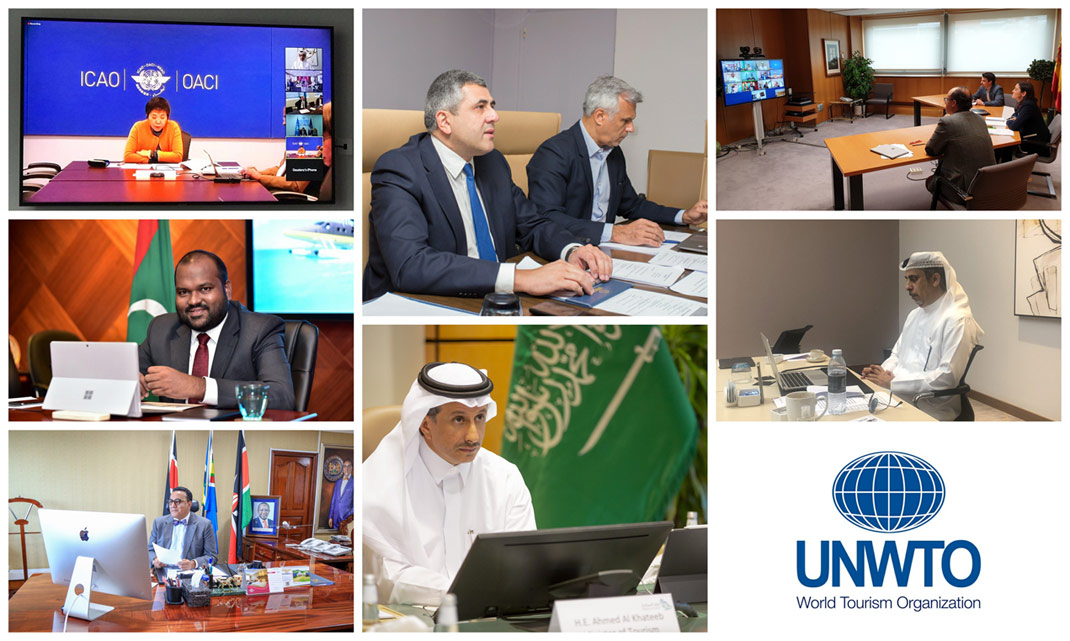
UNWTO recommendations for recovery
In the coming days, UNWTO will release a set of recommendations for recovery . The document will highlight the steps governments and other authorities need to take to mitigate the impact of COVID-19 on the tourism sector and to then accelerate recovery.
Yesterday’s meeting will be factored into UNWTO’s recommendations. These will be complemented by a dynamic component aimed at engaging with innovators across the world through an innovation challenge centred on tourism’s response. Launched with the support of WHO, this challenge will identify new ideas that can be implemented to help tourism return to sustainable growth.
Participants in Thursday’s coordination meeting agreed that this is “a shared challenge that can only be tackled by working together, with recovery dependent on a joint effort on a scale never seen before”.
Global Tourism Crisis Committee
The participants accepted UNWTO’s invitation to be part a global coordination committee which will hold regular virtual meetings to evaluate and advance recommendations as the situation evolves.
The UN’s key tourism related agencies will all be participating, along with WHO and the main representatives of the airline and maritime transportation sectors, as well as the private sector.
UNWTO members are a critical part of this committee, represented through the regional chairs and the chair of the Executive Council.
From within the United Nations , the virtual meeting was attended by WHO Director of Health and Multilateral Partnerships Gaudenz Silberschmidt (sitting in for Director-General Dr. Tedros Adhanom Ghebreyesus), the Secretary-General of ICAO (International Civil Aviation Organization), Dr. Fang Liu, and the Secretary-General of the IMO (International Maritime Organization), Mr. Kitack Lim
UNWTO Members were represented by the Chair of UNWTO Executive Council Najib Balala, Cabinet Secretary for Tourism and Wildlife, Kenya, and by the Chairs of UNWTO’s Regional Commissions : for Africa, Mr. Ronald K. Chitotela, Minister of Tourism, Zambia; for the Americas, Edmund Bartlett, Minister of Tourism, Jamaica; for Asia and the Pacific, Mohd Daud, Undersecretary of Tourism Policy and International Affairs, Malaysia, and for South Asia, Ali Waheed, Tourism Minister, Maldives; for Europe, Harry Theoharis, Minister of Tourism, Greece; and for the Middle East, Mohammed Khamis Al Muhairi, Undersecretary for Tourism, UAE. Special interventions were made by Reyes Maroto, Minister of Tourism, Spain, and by Ahmed bin Aqil Alkhateeb, Minister of Tourism of Saudi Arabia.
Representing the private sector were the Chair of the Board of UNWTO Affiliate Members and also Director of IFEMA Ana Larrañaga; Alexandre de Juniac, Director-General of the International Air Transport Association, ( IATA ); Adam Goldstein, Global Chair, Cruise Lines International Association ( CLIA ); Agnela Gittens, Director General of the Airports Council International ( ACI ), and Jeff Pool from the World Travel & Tourism Council ( WTTC ).
Related Links
- Download PDF
- UNWTO Calls on Tourism to be Part of Recovery Plans
- A Joint Statement on Tourism and COVID-19
- World Health Organization: COVID-19 Advice for the Public
Category tags
Related content, “blanket travel restrictions don’t work”: unwto adds it..., new covid-19 surges keep travel restrictions in place, the world tourism organization unites with tourism mini..., new report shows value of ip to the tourism sector.
- Search Please fill out this field.
- Newsletters
- Inspiration
- Sustainability
Destinations Dependent on Ecotourism Are Facing a Silent Crisis
How travel's abrupt halt affected global conservation efforts
It’s time to rethink travel with a lighter footstep in mind, which is why TripSavvy has partnered with Treehugger , a modern sustainability site that reaches more than 120 million readers each year, to identify the people, places, and things that are leading the charge in eco-friendly travel. Check out the 2021 Best of Green Awards for Sustainable Travel here .
Characterized by responsible travel to natural areas, ecotourism helps conserve the environment, sustain local economies, and is meant to educate travelers on the importance of nature and wildlife in the process. According to the United Nations World Tourism Organization (UNWTO), successful ecotourism contains educational features, highlights small, locally-owned businesses, and minimizes any negative effects on nature and society. Lastly, it supports the conservation and maintenance of the very attractions and destinations upon which it depends.
When you buy an admission ticket to a natural preserve in Costa Rica , for example, that money goes towards the employees who work there as well as conservation and research projects within the preserve. Whether by generating economic advantages for host communities and organizations dedicated to protecting or managing conservation areas, increasing awareness towards wildlife or natural resources, or providing sustainable income opportunities for locals, ecotourism helps maintain the delicate balance between travelers and nature.
What happens, then, when tourism comes to a grinding halt? How does the sudden and sharp decline in ecotourism affect the communities and environments that rely on them?
The Role of Ecotourism
From climate change and habitat loss to poverty and the illegal wildlife trade, conservation has enough obstacles without the added stress of a pandemic. When an industry aimed at providing responsible, nature-based experiences for tourists suddenly stops, it threatens to upend more than just the local economy.
For many communities, and especially for those in underdeveloped countries, the devastating loss in tourism bookings has resulted in a dramatic decrease in funding for both conservation operations and local livelihoods. In certain South and East African countries, emergency relief funds are so difficult to access for nature-based tourism enterprises that the World Wildlife Fund and the Global Environment Facility have organized nearly $2 million to develop an African Nature-Based Tourism Collaborative Platform .
UNWTO found that international tourist arrivals decreased by 74 percent in 2020, representing a loss of approximately $1.3 trillion in tourism-based exports. They also indicated a potential drop in visitor spending that put 100 to 120 million direct tourism jobs in danger, many of them among smaller or medium-sized companies.
Natural areas also stand to suffer as the loss of tourism revenue cuts off funding for conservation and protection. In 2015, a UNWTO survey determined that 14 African countries generated $142 million in entrance fees to protected natural areas. The tourism shutdown means that the areas highly dependent on tourism based jobs are going months with no income and limited options for monetary safety nets. Without these opportunities, communities may have to turn to more exploitative or environmentally unsustainable income sources in order to feed their families.
In some cases, parks agencies rely on tourism for more than half of their operational funding costs. Since there are a substantial number of highly endangered species whose entire population is confined to a single protected area, the preservation of that threatened species is incredibly reliant on tourism revenue. Ecotourism jobs aren’t limited to tour guides or ticket sellers, either, but also include the park rangers and patrollers who work to keep conservation areas safe from illegal poachers, loggers, and miners.
In Brazil, researchers predict that the reduced number of visitors during the 2020 pandemic will lead to a loss of $1.6 billion in sales for tourism businesses that operate around protected areas, as well as a loss of 55,000 permanent or temporary jobs. In Namibia, communal conservancies stand to lose $10 million in direct tourism revenues, threatening funding for at least 700 game guards who conduct anti-poaching patrols.
While there have been plenty of environmental perks to tourism’s interruption (giving the earth a chance to rest from transportation based carbon emissions and allowing wildlife the freedom to live undisturbed from human interaction, to name a few), the pandemic’s negative effects on ecotourism are difficult to ignore.
Reduced Ecotourism Is Taking a Toll on Nature
According to a study commissioned by High Level Panel for A Sustainable Ocean Economy, small island states have seen a 24 percent decline in tourism revenue since the start of 2020. The report also cites that in the Bahamas and Palau, the gross domestic product (GDP) is poised to shrink by at least eight percent, while in the Maldives and Seychelles, the GDP is expected to drop by 16 percent. In 2020, the Fiji Hotel and Tourism Association reported that at least 279 hotels and resorts had closed since the pandemic hit and 25,000 workers had lost their jobs.
The governments in these coastal communities often use revenue from marine tourism to fund marine research, conservation, and monitoring or protection actions. As a case in point, ecotourism makes up over half of the conservation budget needed to protect marine areas from illegal fishing in the Philippines’ Tubbataha Reefs Natural Park.
While a handful of marine protected areas were able to make up the lost revenue with the help of local governments (the Great Barrier Reef, in particular, received emergency funds from the Australian government) others weren't so lucky. The budget for Nusa Penida Marine Protected Area in Indonesia, which faced significant losses of tourism fees in 2020, actually suffered a 50 percent cut in government funding in order to prioritize local pandemic responses.
The International Union for Conservation of Nature's (IUCN) most recent research into the staggering impacts of the pandemic on nature showed that Africa and Asia were the most severely affected. More than half of protected areas in Africa were forced to either halt or reduce field patrols, anti-poaching operations, and conservation education as a result of the pandemic.
In Uganda , where acute conservation efforts between 1996 and 2018 brought the mountain gorilla off the red list of critically endangered species, the substantial population increase achieved over the few decades is under threat of reversal. Because of the decrease in ecotourism during the pandemic, the main source of revenue for gorilla conservation in Uganda has all but dried up. Even worse, the loss of reliable sources of income from tourism-based jobs in surrounding communities could push locals to turn to poaching in order to make ends meet.
After an incident in Cambodia where poachers killed three giant ibises, a critically endangered bird species, the Wildlife Conservation Society revealed that there had been a sudden upsurge in poaching in the area since the pandemic began. The three birds accounted for 1 to 2 percent of the entire global population.
In late April 2020, the conservation non-profit Panthera reported that there had been an increase in wild cat poaching, especially jaguars and pumas, during that year's pandemic lockdown in Colombia. The organization feared that poachers were feeling more confident in expanding their reach into conservation areas since the lockdown had decreased patrolling and law enforcement due to layoffs.
Poaching isn’t the only factor causing rifts in nature-based tourism; according to Brazil's National Institute for Space Research, deforestation in the Brazilian rainforest increased by 64 percent in April of 2020 compared to the same month in 2019. So much so that the Brazilian Armed Forces deployed 3,000 soldiers and environmental officials to help control the influx of illegal loggers who’d continued to operate during the shutdown. Activists are worried that the rampant activity could also threaten indigenous communities, who live isolated from foreign diseases.
The Future of Responsible Ecotourism
Now that the world has seen its implications, will the pandemic inspire the tourism industry to prioritize nature-based ecotourism in the future? The global crisis certainly allowed us an opportunity to rethink the relationship between tourism and nature, as well as how the industry impacts social and environmental resources. If travelers take the time to make more informed decisions, they have the power to drive the economic demand for legitimate and sustainable ecotourism.
Dr. Bruno Oberle, IUCN 's director general, said it best in an accompanying statement to the 2021 journal release: "While the global health crisis remains a priority, this new research reveals just how severe a toll the recent pandemic has taken on conservation efforts and on communities dedicated to protecting nature. Let us not forget that only by investing in healthy nature can we provide a solid basis for our recovery from the pandemic, and avoid future public health crises."
There are a few ways that travelers can prioritize responsible, sustainable ecotourism on future trips. Before booking, find out if the organization provides direct financial contributions or benefits to the conservation of its natural ecosystems and wildlife. Also, don’t be afraid to ask your tour company or accommodation about the steps they take to protect the local environment. Look for activities like recycling or reducing, sourcing local products instead of imported ones, encouraging sustainable practices (such as bringing reusable water bottles or using reef-safe sunscreen ), and offering educational or awareness programs to teach their guests about the importance of the surrounding natural areas. Ecotourism is about using tourism as a valuable tool for conservation and economy, not as an excuse for exploiting natural resources.
Successful ecotourism employs members of the local communities but also recognizes the rights and cultural beliefs of the local people as a whole. Generating financial benefits for local people and businesses is just the tip of the iceberg; it's important for ecotourism agencies to work in partnership with locals to empower them. The pandemic was a good learning experience for many businesses that are heavily reliant on tourism revenues to maintain successful operations; going forward, there may be more emphasis placed on finding ways to foster long term sustainable benefits to host communities so that they aren’t hit so hard in the event that tourism is cut off again in the future.
UN World Tourism Organization. "Ecotourism and Protected Areas."
Conservation International. "Costa Rica."
United Nations World Tourism Organization. " 2020: Worst Year in Tourism History With 1 Billion Fewer Arrivals ." January 28, 2021
United Nations World Tourism Organization. " Towards Measuring the Economic Value of Wildlife Watching Tourism in Africa ." 2015. Page 3.
- Ralf C. Buckley, J. Guy Castley, Fernanda de Vasconcellos Pegas, Alexa C. Mossaz, Rochelle Steven. "A Population Accounting Approach to Assess Tourism Contributions to Conservation of IUCN-Redlisted Mammal Species." September 12, 2012
The International Journal of Protected Areas and Conservation. "Tourism in Protected and Conserved Areas Amid the COVID-19 Pandemic." March 2021
Ocean Panel. "A Sustainable and Equitable Blue Recovery to the COVID-19 Crisis." Page 18.
Parks Journal. "Marine Protected and Conserved Areas in the Time of COVID-19." March 2021. Volume 27, Page 90.
The International Journal of Protected Areas and Conservation. "Impacts of COVID-19 on Protected and Conserved Areas: A Global Overview and Regional Perspectives." March 2021.
Mongabay News. "Poachers Kill 3 Near-Extinct Giant Ibises Amid Pandemic Pressure in Cambodia." April 21, 2020.
Newsweek. "Spike in Big Cat Poaching During Coronavirus Lockdown in Colombia, Conservation Group Says." April 23, 2020.
CNN. "Deforestation in the Amazon is Accelerating Despite Coronavirus." May 15, 2020.
Related Articles
More related articles.
Rising global temperatures are already affecting the tourism industry - here's how

From rising heat to rising seas, holiday hotspots the world over are at risk from climate change. Image: Gaddafi Rusli on Unsplash
.chakra .wef-1c7l3mo{-webkit-transition:all 0.15s ease-out;transition:all 0.15s ease-out;cursor:pointer;-webkit-text-decoration:none;text-decoration:none;outline:none;color:inherit;}.chakra .wef-1c7l3mo:hover,.chakra .wef-1c7l3mo[data-hover]{-webkit-text-decoration:underline;text-decoration:underline;}.chakra .wef-1c7l3mo:focus,.chakra .wef-1c7l3mo[data-focus]{box-shadow:0 0 0 3px rgba(168,203,251,0.5);} Ian Shine

.chakra .wef-9dduvl{margin-top:16px;margin-bottom:16px;line-height:1.388;font-size:1.25rem;}@media screen and (min-width:56.5rem){.chakra .wef-9dduvl{font-size:1.125rem;}} Explore and monitor how .chakra .wef-15eoq1r{margin-top:16px;margin-bottom:16px;line-height:1.388;font-size:1.25rem;color:#F7DB5E;}@media screen and (min-width:56.5rem){.chakra .wef-15eoq1r{font-size:1.125rem;}} Travel and Tourism is affecting economies, industries and global issues

.chakra .wef-1nk5u5d{margin-top:16px;margin-bottom:16px;line-height:1.388;color:#2846F8;font-size:1.25rem;}@media screen and (min-width:56.5rem){.chakra .wef-1nk5u5d{font-size:1.125rem;}} Get involved with our crowdsourced digital platform to deliver impact at scale
Stay up to date:, travel and tourism.
Listen to the article
- Tourism is crucial to many economies, but rising global temperatures are putting parts of the industry at risk.
- The climate crisis is changing the face of many tourist destinations and is already making some holidaymakers rethink their plans.
- The World Economic Forum’s Global Future Council on the Future of Sustainable Tourism is working to help the tourism sector build towards a more sustainable future.
Hot weather is what many people go on holiday for. But record global temperatures have been sending people home early from their vacations this July, raising questions about what kind of impact the climate crisis could have on the tourism sector – and on tourism-dependent economies.
Greece – where travel and tourism make up 15% of GDP – has had to evacuate over 2,000 holidaymakers after wildfires broke out on the island of Rhodes. Athens took the unprecedented step of closing its top tourist attraction, the Acropolis, after temperatures reached 45°C .
"The climate crisis is already here ,” said Greek Prime Minister Kyriakos Mitsotakis. “It will manifest itself everywhere in the Mediterranean with greater disasters."

Over in Italy, visitors to Rome have been returning home early because of the heatwave, while hospitals have faced a rise in the number of medical emergencies . Admissions at one hospital reached their highest since the COVID-19 pandemic.
Soaring temperatures have not just been ending holidays – they’ve even stopped some from getting started. This is because aircraft find it harder to get off the ground in hotter conditions, as it makes the air less dense .
US airlines flying out of Las Vegas – where temperatures hit 46°C – have consequently had to reduce passenger numbers, remove baggage, reduce the level of fuel they are carrying or delay flights until temperatures fall.
The impact of the climate crisis on tourism
The climate crisis has played an "absolutely overwhelming" part in the northern hemisphere heatwave , according to World Weather Attribution. And heatwaves will become hotter and longer unless the world quickly halts its use of fossil fuels, they say.
The tourism sector creates around a tenth of the greenhouse gas emissions that are driving the climate crisis , according to the World Travel & Tourism Council. Practically half of all transport emissions stem from global tourism, other studies say. And total emissions from tourism are forecast to rise by a quarter between 2016 and 2030, says the UN World Tourism Organization.

But the tourism industry and tourism-dependent economies are also highly vulnerable to the impacts of rising temperatures.
The Caribbean attracted over 28 million visitors in 2022 and its economy is more reliant on travel and tourism than any other region , according to the World Travel & Tourism Council. Tourism makes up around 90% of GDP in Aruba and the British Virgin Islands .
Yet these low-lying states are seeing sea levels rise almost 10% faster than the global average , according to the World Meteorological Association. The vast majority of holiday resorts in the Caribbean are coastal, leaving 60% of them at risk from sea level rise , according to the University of Cambridge.
Biodiversity damage
Coral bleaching and increasing droughts are already impacting the Caribbean’s tourism potential , the UK government notes.
Meanwhile, South-East Asia’s most popular costal destinations are suffering environmental damage from factors including pollution and overtourism . Thailand’s Maya Bay, Malaysia’s Sipadan Island and the Philippines’ Boraca Island are all being impacted, and some countries in the region are now closing tourist spots to give the most damaged areas time to recover , the Harvard School of Public Health notes.
“As the prime motivation for visitors to come to the region hinges on local landscapes, biodiversity, heritage and cultures, the sector’s survival depends on the ability to retain and preserve as much of these natural resources as possible,” The ASEAN Post reports.
The prospects of African safaris could also be hit by the climate crisis, which is forecast to lead to the loss of over half of the continent’s bird and mammal species by 2100 and trigger huge losses of plant species .
Measures are being taken to protect the continent’s natural bounties. The Seychelles islands off East Africa have added conservation guidlines to the national constitution – the first time a country has done so.
Sustainable, nature-based tourism is a potentially huge economic driver for Africa , and could create 40% more full-time jobs than agricutlure, the UN Environment Programme says.
High temperatures will change tourism patterns
Rising temperatures are likely to result in tourists travelling in spring and autumn rather than the summer , as well as opting for cooler destinations, Italy’s environment ministry says.
There has already been a 10% drop in the number of people planning to visit the Mediterranean in June-November this year following last year’s high temperatures, according to the European Travel Commission. It says tourists are considering trips to the Czech Republic, Denmark, Ireland and Bulgaria instead.
On top of this, “ large-scale land loss” is already eating into the Mediterranean’s beaches , according to Germany’s federal environment agency. One beach in Mallorca now has space for half the amount of huts it used to have, as well as fewer sun loungers, DW News reports.
The Global Risks Report 2023 ranked failure to mitigate climate change as one of the most severe threats in the next two years, while climate- and nature- related risks lead the rankings by severity over the long term.
The World Economic Forum’s Centre for Nature and Climate is a multistakeholder platform that seeks to safeguard our global commons and drive systems transformation. It is accelerating action on climate change towards a net-zero, nature-positive future.
Learn more about our impact:
- Scaling up green technologies: Through a partnership with the US Special Presidential Envoy for Climate, John Kerry, and over 65 global businesses, the First Movers Coalition has committed $12 billion in purchase commitments for green technologies to decarbonize the cement and concrete industry.
- 1 trillion trees: Over 90 global companies have committed to conserve, restore and grow more than 8 billion trees in 65 countries through the 1t.org initiative – which aims to achieve 1 trillion trees by 2030.
- Sustainable food production: Our Food Action Alliance is engaging 40 partners who are working on 29 flagship initiatives to provide healthy, nutritious, and safe foods in ways that safeguard our planet. In Vietnam, it supported the upskilling of 2.2 million farmers and aims to provide 20 million farmers with the skills to learn and adapt to new agricultural standards.
- Eliminating plastic pollution: Our Global Plastic Action Partnership is bringing together governments, businesses and civil society to shape a more sustainable world through the eradication of plastic pollution. In Ghana, more than 2,000 waste pickers are making an impact cleaning up beaches, drains and other sites.
- Protecting the ocean: Our 2030 Water Resources Group has facilitated almost $1 billion to finance water-related programmes , growing into a network of more than 1,000 partners and operating in 14 countries/states.
- Circular economy: Our SCALE 360 initiative is reducing the environmental impacts of value chains within the fashion, food, plastics and electronics industries, positively impacting over 100,000 people in 60 circular economy interventions globally.
Want to know more about our centre’s impact or get involved? Contact us .
The spike in temperatures is also worrying the organizers of the 2024 Olympics Games in Paris . They are closely monitoring long-term weather models, with International Olympic Committee President Thomas Bach saying the climate crisis is affecting how sporting events – a major driver of tourism – will be organized around the globe.
Colder climates are suffering, too
The Alps region attracts around 120 million tourists a year , and tourism is critical to the economies of many local towns. Skiing and snowboarding are top of many visitor lists, but rising global temperatures have reduced seasonal snow cover in the Alps by 8.4% per decade in the past 50 years.
Canada’s Whistler ski resort has responded to this by offering more snow-free activities – so much so that it now makes more money in summer, according to TIME magazine.

But adapting in this way is not an option for all tourism destinations, such as coastal resorts. With coastal tourism accounting for more than 60% of European holidays and more than 80% of US tourism revenues, the tourism industry and the countries that rely on it may need to urgently rethink the way they operate.
“In the coming years, the success of travel and tourism businesses and destinations will be increasingly tied to their ability to manage and operate under ever greater ecological and environmental threats,” says the World Economic Forum’s Travel & Tourism Development Index .
Have you read?
Is 2023 going to be the hottest year on record, what is sustainable aviation fuel and why are only 0.1% of flights powered by it, how global tourism can become more sustainable, inclusive and resilient, how tourism can change.
Sustainable tourism is one way to help protect countries and economies at risk from the climate crisis. It is also one of the UN’s Sustainable Development Goals .
The UN World Tourism Organization defines sustainable tourism as “tourism that takes full account of its current and future economic, social and environmental impacts, addressing the needs of visitors, the industry, the environment and host communities".
This could include limiting tourist numbers (as is being done in Southern France to help protect ecosystems ), banning polluting forms of transports (as the Dutch capital Amsterdam is doing with cruise ships and the Spanish city of Barcelona is trying to do ).

Staying only in environmentally friendly resorts is another option. Some are ensuring they run on renewable power, harvest rainwater and cut waste.
Avoiding flying is another option. British eco-charity Possible is promoting this through its Climate Perks initiative . UK companies who sign up agree to give staff increased paid leave to cover the time needed for slower, greener modes of transport such as trains or coaches when they go on holiday.
Ditching planes is also part of the “slow travel” trend . It advocates dropping the “bucket list” approach of ticking off as many destinations as possible, with travellers instead staying in one place and experiencing a local culture more fully.
The World Economic Forum’s Global Future Council on the Future of Sustainable Tourism is working to help the tourism sector create pathways towards net-zero, nature-positive tourism that benefits local communities.
“Diversifying tourism strategies and activities is essential for countries to build resilience against economic fluctuations, mitigate overreliance on a single industry, and foster sustainable development that benefits both the local communities and the environment,” says Topaz Smith, Community Lead for Aviation, Travel and Tourism at the World Economic Forum.
“Long-term planning is crucial for a more risk-resilient travel and tourism sector that anticipates and plans for future headwinds while maximizing development potential.”
Don't miss any update on this topic
Create a free account and access your personalized content collection with our latest publications and analyses.
License and Republishing
World Economic Forum articles may be republished in accordance with the Creative Commons Attribution-NonCommercial-NoDerivatives 4.0 International Public License, and in accordance with our Terms of Use.
The views expressed in this article are those of the author alone and not the World Economic Forum.
Related topics:
The agenda .chakra .wef-n7bacu{margin-top:16px;margin-bottom:16px;line-height:1.388;font-weight:400;} weekly.
A weekly update of the most important issues driving the global agenda
.chakra .wef-1dtnjt5{display:-webkit-box;display:-webkit-flex;display:-ms-flexbox;display:flex;-webkit-align-items:center;-webkit-box-align:center;-ms-flex-align:center;align-items:center;-webkit-flex-wrap:wrap;-ms-flex-wrap:wrap;flex-wrap:wrap;} More on Industries in Depth .chakra .wef-zh0r2a{display:-webkit-inline-box;display:-webkit-inline-flex;display:-ms-inline-flexbox;display:inline-flex;white-space:normal;vertical-align:middle;padding-left:0px;padding-right:0px;text-transform:uppercase;font-size:0.75rem;border-radius:0.25rem;font-weight:700;-webkit-align-items:center;-webkit-box-align:center;-ms-flex-align:center;align-items:center;line-height:1.2;-webkit-letter-spacing:1.25px;-moz-letter-spacing:1.25px;-ms-letter-spacing:1.25px;letter-spacing:1.25px;background:none;padding:0px;color:#B3B3B3;-webkit-box-decoration-break:clone;box-decoration-break:clone;-webkit-box-decoration-break:clone;}@media screen and (min-width:37.5rem){.chakra .wef-zh0r2a{font-size:0.875rem;}}@media screen and (min-width:56.5rem){.chakra .wef-zh0r2a{font-size:1rem;}} See all

Why having low-carbon buildings also makes financial sense
Guy Grainger
September 18, 2024

Microplastics: Are we facing a new health crisis – and what can be done about it?
Joe Myers and Madeleine North
September 3, 2024

5 must-reads that will get you up to speed on the energy transition
David Elliott
August 19, 2024

From source to stomach: How blockchain tracks food across the supply chain and saves lives
Matthew Van Niekerk
August 12, 2024

From blocked views to free food: How holiday destinations in Japan, Denmark and more are tackling overtourism
Gabi Thesing, Ian Shine and David Elliott
July 25, 2024

How these 5 steel producers are taking action to decarbonize steel production
Mandy Chan and Daniel Boero Vargas
June 25, 2024
- ENVIRONMENT
- FOREIGN AFFAIRS
- REAL ESTATE
- WHAT’S ON
- LATEST NEWS
- REIMAGINE TOURISM
- GREEK EDITION
The paradox of Greece’s most popular destination
After a series of record-breaking years, the island is seeing a decline in arrivals, but visitor satisfaction remains high.

After a series of record-breaking years, the island is seeing a decline in arrivals. This drop is often attributed to the pressures of rapid development. However, visitor satisfaction remains high. Here’s a look at Greece’s most popular destination.
In recent summers, the news from Mykonos has been largely negative. The island frequently makes headlines for issues of profiteering, serious crimes, mafia-style attacks, building violations and viral posts from influencers charged hundreds of euros for simple dishes like fried squid and Greek salad.
Yet, more than 1.5 million people visit Mykonos each year, with another 1.2 million arriving by cruise ship. This small island, with 11,000 residents and covering just 85 square kilometers, hosts more tourists annually than Peru. Clearly, something attracts them.
So, what’s the real story behind Mykonos tourism? Who are the visitors, how many come and how do they feel about their experience? Is tourism declining? Data from international organizations, compiled by INSETE, the research arm of the Greek Tourism Confederation, provides insight.
By analyzing this data, we can better understand Mykonos as a tourism destination today – and debunk a few myths. Let’s break it down.
In 2023, more people flew directly to Mykonos from abroad than in 2019, but slightly fewer than in 2022. International arrivals in the first half of 2024 were down 5% from 2023. While concerns about declining numbers are valid, domestic air arrivals rose in 2023 and have continued to increase slightly in 2024. Despite a slight drop from record highs, large numbers of people still fly to Mykonos.

Cruise ship traffic surged in 2023, with 749 ships bringing 1.2 million passengers to Mykonos – almost double the 2022 total and well above 2019 levels. Nearly 800,000 people also arrived by ferry, slightly fewer than in 2019.
The total revenue from Mykonos accommodations reaches €750 million, with €500 million from 5-star hotels. This explains the boom in luxury hotel construction

Where do all these visitors stay?
In 2023, Mykonos had the capacity to host about 50,000 tourists per night, with 225 hotels and over 5,000 short-term rentals booked on platforms such as Airbnb. Hotels offer around 8,000 rooms with 16,500 beds – 3,000 more than in 2019. Short-term rentals, including homes, apartments and villas, add over 33,000 beds, with an average of six people per rental. For an island of 11,000 residents, over 5,000 rental properties is a notable figure.
Mykonos is known for its luxury accommodations. Seventy-three of its hotels are 5-star, with 7,500 beds, almost matching the island’s population. Factoring in high-end villas, which bring in significant revenue, the luxury market is even larger.
In 2019, each 5-star hotel room generated an average of 87,000 euros annually, compared to €36,000 for 4-star hotels and €16,000 for short-term rentals. The total revenue from Mykonos accommodations reaches €750 million, with €500 million from 5-star hotels. This explains the boom in luxury hotel construction – 27 of the island’s 73 5-star hotels opened after the pandemic.
Most visitors book their accommodation online. In 2023, 64% used Booking.com, 20% used Google, 9% TripAdvisor and 4% Hotels.com, with the rest using other sources. Sixty percent of hotel guests were couples, 22% families, 9% large groups and 8% solo travelers.
How do all these visitors rate their experience?
Various organizations gather data on tourism, including visitor satisfaction and destination profiles. The Net Promoter Score (NPS), for example, gauges customer satisfaction by asking if they would recommend a service. Recent NPS results show Mykonos hotels consistently rate highly compared to other Mediterranean destinations.
NPS categorizes customers as detractors, passives or promoters. Detractors are dissatisfied and unlikely to recommend the service, passives are neutral, and promoters are highly satisfied and likely to recommend the service. When comparing data from 2019, 2022 and 2023 across five popular Mediterranean destinations, including Saint-Tropez, Ibiza and Sardinia, the two Greek islands, Santorini and especially Mykonos, often lead in customer satisfaction.
Another benchmark, the Guest Reputation Index (GRI), assesses online hotel reviews by analyzing data from travel sites and agents. The results are similar: Mykonos and Santorini consistently rank highest. No foreign destinations surpassed them; the only blip was a brief period in the summer of 2022 when Santorini’s ratings equaled Mykonos’, which generally ranked first.

Top ratings
Visitors to Mykonos gave high marks for accommodation quality, staff and cleanliness, but slightly lower ratings for value for money and sustainability. Australians, Brits and Americans rated the island over 9 out of 10 in 2023.
While recent negative news and a slight drop in arrivals are concerning, Mykonos remains a top destination, especially for high-income travelers. Its continued success will depend on how the government, local community and tourism operators address current challenges and maintain high standards. There is much work ahead to preserve its appeal.
Subscribe to our Newsletters
Enter your information below to receive our weekly newsletters with the latest insights, opinion pieces and current events straight to your inbox.

Dive into Greece, says Deputy Tourism Minister

Greeks priced out of vacation

Turkish tourists flock to Samos using express visa program
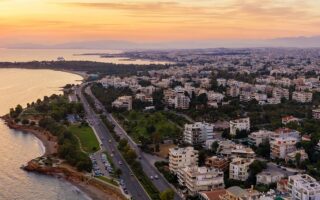
Hotel investors increasingly honing in on Greece
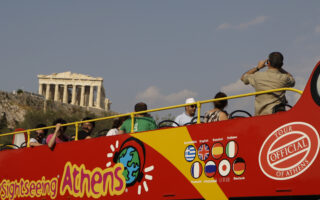
Tourism provides third of Greek GDP, most jobs
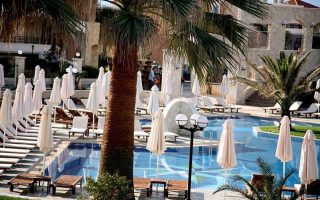
Hotel turnover up 23% in 2023
- Places - European, Western and Northern Russia
KHANTY-MANSI AUTONOMOUS OKRUG: RUSSIA’S MAIN OIL-PRODUCING REGION
Khanty-mansi autonomous okrug.
Khanty-Mansi Autonomous Okrug is usually called Yugra or Ugra for short. It is named after two indigenous groups native to the region — the Khanty and the Mansi, known collectively as Ob-Ugric people. It covers 534,800 square kilometers (206,500 square miles), is home to about 1.53 million people and has a population density of 2.9 people per square kilometer. About 91.5 percent of the population live in urban areas. Khanty-Mansiysk is the capital, with about 80,000 people. The largest cities are Surgut, Nizhnevartovsk, and Nefteyugansk.
As of the early 2010s, about 51 percent of the oil produced in Russia and 7.3 percent of the world’s supply came from Khanty–Mansi Autonomous Okrug, making the region very important economically. More than 10 billion tons of oil has been was recovered from the okrug’s fields so far . The okrug contains around 70 percent of Russia’s developed oil fields, about 450 in total, including Samotlor, which is the largest oil field in Russia and the sixth largest in the world. Gas was first found in the region in 1953 and oil began to be produced in 1960.
As far as tourism is concerned this autonomous okrug combines unique historical, cultural and natural resources, the most important of which is the way of life of its indigenous peoples. If you visit a nomad camp, you can ride on a reindeer sleigh, live in a chum tent, learn to harness a deer, ride a sled and taste stroganina (slices of frozen meat) and patanka (thinly sliced frozen fish). In the Sub-Arctic Ural Mountains, it is popular to climb Mount Narodnaya — the highest peak of the Urals — and go fishing.
The winter in Khanty-Mansiysk is cold. Snow lies on the ground about 200 days of the year and temperature of -50 degrees, C are not unusual. The summer are short but sometimes can get surprisingly hot, with temperature over 30 degree heat. The best time to visit is May or or September, when it is not yet cold and the annoying mosquitos, no-see-ums and midges are not out in full force.
Getting There: By Plane: The flight Moscow or St. Petersburg to Khanty-Mansiysk is about three hours. To Surgut, three and a half. To Nizhnevartovsk, four hours. The cost of an adult round-trip economy class ticket is from 8,000 to 12,000 rubles, depending on the airline. The airport of Nizhnevartovsk. Website: /nvavia.ru. Phone +7 (3466) 49-21-75. By Train: you can reach Surgut, Nizhnevartovsk, Yugorsk, Nyagan and Kogalym. Trains do not reach Khanty-Mansiysk. The nearest station to it, Demyanka, is located 240 kilometers away. From it to the capital of Ugra there are minibuses. A round-trip ticket for a berth in a compartment from Moscow to Surgut is 14,000 rubles. The trip takes two days.
By Car: Two roads lead to Yugra. The main one is the Federal highway R404 Tyumen-Khanty-Mansiysk. This is convenient if you are going to the eastern part of the okrug. If you need to go to the western part or to the capital, it is better to go by the Northern route — through Perm, Serov, Ivdel and Yugorsk. The road quality on both routes is pretty good, but there is much less traffic on the northern one. If you are traveling in Ugra by car, do not forget to refueling. The distances gas stations can reach 200 kilometers or more. It is a good idea to have a canister of fuel in the trunk just in case. Regional Transport By Bus: From Khanty-Mansiysk to Surgut is 300 kilometers, Bus tickets range from 1100 to 1400 rubles. From Surgut to Nizhnevartovsk — 220 kilometers — bu bus costs about 1000 rubles. From Surgut to Kogalym — 80 kilometers — is about 500 rubles. The bus station in Nizhnevartovsk. Website: www.nvav.ru. Phone: 8 (3466) 45-72-97.
Accommodation in the Region: In all major cities there are a lot of hotels. The level of service is high everywhere, but the prices are also high: starting from 5,000-6,000 rubles for a standard price double room. It is much cheaper to rent apartments, at 1,500 to 2,500 rubles.
Khanty and Mansi
The Khanty (pronounced HANT-ee) are a group of Finno-Ugric-speaking, semi-nomadic reindeer herders. Also known as Ostyaks, Asiakh, and Hante they are related to the Mansi, another group of Finno-Ugric-speaking reindeer herders. Only about 60 percent of Khanty speak their native language and a much smaller percentage live in the forest. In the Khanty-Mansiisk District they are fa r outnumbered by other ethnic groups. [Source: John Ross, Smithsonian; Alexander Milovsky, Natural History, December, 1993]
There are about 23,000 Khanty. They live primarily in Khanty-Mansi Autonomous Okrug , a region along the northern tributaries of the Ob River in northwestern Siberia about 1,100 miles northwest of Moscow and 200 mile south of the Arctic Circle. Their cousins, the Mansi, also live there. The region has been damaged by oil and natural gas exploration and production.
The Mansi, known in the old days as the Voguls, are close relatives of the Khanty and live primarily in Khanty-Mansi Autonomous Okrug.. There are around 8,000 or so Mansi. The Mansi have traditionally survived by fishing, hunting and gathering, The hunting methods they employed and the animals they went after was determined by what was available. Often they relied chiefly on fishing and dried enough fish during the summer to last through the winter. They hunted elk, bears, wild reindeer with spears, bows and arrows and traps until the 19th century when the began using firearms. Elk were caught with a system of traps and triggered bows.
Many Mansi still hunt. They use dogs and firearms and go chiefly after muskrats and squirrels. Sable are hunted with nets and guns by a pair of hunters: one who flushes the sable from its den into the net and the other who shoots the animal. Their traditional religion is often aimed at securing a successful hunt.
KHANTY factsanddetails.com ;
Oil and Natural Gas in Khanty-Mansi Autonomous Okrug
Oil was prospected in the West Siberia from the beginning of the 20th century. Local people reported finding discharges on the surface from time to time. The first Soviet prospectors arrived to Ugra in 1935. They confirmed the presence of natural oil seeps on the Ugan river in the Surgut area. Over 2.5 tons of equipment were delivered to the drilling pad by air. Other supplies were hauled by horses, since the nearest railroad ran about 1,000 km away from the prospecting site. The place was very remote and was only accessible during the winter. The early workers lived in a camp under extremely cold conditions. [Source: Technologies Department of Ugra]
In 1953, natural gas was found for the first time in Western Siberia, in Berezovo, about 300 kilometers northwest of Khanty-Mansiysk. in Berezovo. In 1960 the first oil was found in the vicinity of Shaim. Soon after oil fields were discovered in Megion, West Surgut, Pokur, Vatinsky, Mamontovo, Salym, Pravdino and other places. The biggest discovery was in 1965, when the first oil gushed out from the marshland at Samotlor. One of the largest oil fields in the world, it has already produced 2.67 billion tons of oil.
Oil quality in the region is quite high. Some is light, some is black, but most of it is brown. Its characteristics and composition can differ significantly even within the same field. In 2013 255.1 million tons of oil were produced in Khanty-Mansi Autonomous Okrug and eight new fields were brought into development. Total gas production in Ugra was 33,0 billion cubic meters in 2013. This was mostly associated petroleum gas.
Owing to its explored and proven raw hydrocarbons resources, production capabilities, industrial infrastructure and oil fields commercial viability Yugra will remain Russia’s main strategic raw hydrocarbons resource base for the next several decades. Over 475 oil and gas fields have been discovered in the territory of the Khanty-Mansiysk Autonomous Okrug. Total length of the region's pipelines network is 107,000 kilometers.
Ob River (flowing northeast of Novosibirsk and Tomsk) is the forth longest river in the world if you include its major tributary the Irtysh River and the seventh longest without it. The westernmost of three great rivers of Asiatic Russia, the Ob is 3,650 kilometers (2,270 miles) long and is an important commercial waterway that transports goods back and forth between the Trans-Siberian Railway and the resource rich regions of northern Siberia. Since it is frozen over half the year activity on the river is concentrated mostly in the summer months. The Ob-Irtysh is over 5570 kilometers (3461 miles) long
The Ob and the Irtysh River begin in the Altay Mountains, a range located near where Russia, China, Kazakhstan and Mongolia all come together, and flow northward. Although the Ob and the Irtysh begin at points within a couple of hundred miles of one another the two rivers don't join until the Irytysh has traveled over 1,600 kilometers (1000 miles). Once the two rivers have dropped down out of the highlands the meander lazily through open steppes, then rich farmland, and meet in flat, swampy plains, where the width of river ranges between a half a kilometer and a kilometer and a half. The Ob then passes through fir and spruce forests of West Siberia, then through Arctic tundra before finally emptying into the Kara Sea, an arm of the Arctic Ocean. The Ob is one of the great Asiatic Russian rivers (the Yenisei and the Lena are the other two). According to the Guinness Book of World Records, it has the longest estuary (550 miles long and up to 50 miles wide) and is widest river that freezes solid. The mouth of the river on the Arctic Ocean is ice free only a couple of months a year. Huge flood sometimes form in the spring when high waters fed by melting snow and ice meet still frozen section of the river.
The main city on the Ob is Novosibirsk. Parts of the Ob are very polluted and nearly void of life. At the mouth of the river so much land has been degraded by gas exploration that huge chunks of permafrost land have literally melted into the sea. [Source: Robert Paul Jordan, National Geographic, February 1978, ♬]
Traveling on the Ob and Irtysh Rivers
There is a regualr ferry the Ob and Irtysh Rivers that travels between Omsk – Tobolsk – Khanty-Mansiysk – Berezovo and Salekhard (Yamal Nenets Autonomous Region). Omsk and Tobolsk both have train stations on the Trans-Siberian Railway. Khanti-Mansiysk is accessible by bus from Tyumen, which has a train station. After Khanti-Mansiysk you are beyond the road network. As well as the major stops listed on the route above, the boat also stops at plenty of isolated indigenous villages in between them. Salekhard is the only city in the world located exactly on the Arctic Circle.
The name of the ferry is the Rodina. It travels three times a month in June and September and four times a month in July and August. Going from Salekhard to Omsk: Day 1): departs Salekhard at 5:00pm; Dat 2) stops at Berezovo for 30 minutes ay 7:30pm; Day 3) stops at Oktobraskaya Market for one hour. Day 4) stops at Khanty-Mansiysk for two hours at 8:00am; Day 6) one hour stop in Tobolsk at 7:30. Day 9) arrive in Omsk at 3:00pm. Traveling the other direction, with the current, takes one third less time.
On the Salekhard - Tobolsk - Omsk trip on person posted on Lonely Planet’s Thorn Tree forum in 2013: “I'll start by saying that this boat is amazingly good value for money. Here some example prices. The first is for beds in the common area, similar to platzkart on the train, the second is for a bed in a private 4-, 6-, or 8 bed cabin and the third is for a bed in a private 2 bed cabin. 1) Salekhard - Omsk (8 days): 1162 / 1437 / 3926 roubles; 2) Salekhard - Tobolsk (5 days): 774 / 969 / 2632 roubles; 3) Tobolsk - Khanty-Mansiysk (2 days): 429 / 526 / 1394 roubles. Children go half price!
“Tickets can be bought in advance at the airport in Salekhard or on the boat itself an hour before departure (it's apparently never full). Most people get off at one of the stops in the first 24 hours when going south from Salekhard, leaving only one or two people in most of the cabins for most of the route. The beds are comfortable , both longer and wider than on trains. Everything is cleaned several times a day, there's a shower, laundry, restaurant with simple but tasty meals and alcohol. Breakfast about 70 roubles, lunch and dinner 150 - 300, beer 50 - 80, wine, vodka and so on also available. Theres also a small room where films are shown starting in the afternoon and a shop selling all sorts of useful stuff such as toiletries, mugs, books.
“You can walk around on deck as much as you want or sit and read a book on the benches up there. The scenery is more or less the same all the way - endless taiga forest with absolutely no sign of civilisation. There are a few villages such as Pitlyar for which the boat is their only access to the outside world and a couple of towns where you can get off the boat and walk around - Beryozovo 24 hours after Salekhard and Khanty-Manskiysk 3 days from Salekhard. From Khanty Mansiysk there are regular buses to Tyumen on the Trans Siberian which take 8 hours. At Tobolsk the boat stops next to the stunning kremlin, the only one in Siberia.
“Anyone can freely sail the whole route between Omsk and Pitlyar, a small village of 500 and the last stop before Salekhard. Salekhard and areas north are closed to outsiders, Russian or otherwise, unless they get a temporary permit. See the Yamal Peninsula link in my signature line for how to get this permit. Permit in hand, you can continue the journey north from Salekhard a further two days to Antipayuta, well beyond the Arctic Circle, with a similar level of comfort and price.
“It sails the whole route from June to September and once in October from Khanty-Mansiysk to Omsk. Check www.irsc.ru for timetables and fares. Only about half the boats from Salekhard go as far as Omsk, the rest stopping in Tobolsk. Eg in July and August, the most frequent sailing months, 6 boats go from Salekhard - Tobolsk each month but only 3 continue to Omsk. Check the timetable carefully when planning if you want to sail all the way to Omsk!”
Khanty-Mansiysk City
Khanty-Mansiysk is the capital of the Khanty-Mansiysk Autonomous Okrug and home to about 80,000 people. Despite its remote location and relatively small size, it has a Norman Foster skyscraper, world-leading medical center that is free and has hosted international film festivals, major sports events and political summits. How is this possible?: Oil wealth and close ties between local politicians and Russian President Vladimir Putin doesn’t hurt.
Khanty Mansiysk has showy headquarters for Russia’s main oil companies: Rosneft, Lukoil and Gazprom-Neft. Not far away enormous drilling towers rise and gas flares burn above the birch forests and pipelines cut through the landscape. Around 90 percent of the city’s economic revenues are tied directly to the oil and gas industries.
The city is located in a picturesque area of the West Siberian lowland, where steep hills overgrown with age-old dwarf pine, rise up from the right bank of the mighty Irtysh River. Two of the largest rivers of Siberia — the Irtysh and the Ob — merge twenty kilometers from the city. Not far from town the “Coniferous Urman” ski complex with a cable car. The cedar forest of the Samarovsky Chugas Park has trails for cross-country skiing and hiking. For children there is a water park and a small zoo in the village of Shapsha 20 kilometers from the city. In the summer, there are boat tours to the confluence of the Ob and Irtysh, where you can see the floating chapel-lighthouse.
Places of interest to tourists the gold domes of the Church of Christ’s Resurrection; the gallery of the artist Gennady Raishev; the Geology, Oil and Gas Museum, which traces the history of Western Siberian oil and gas development; and the open-air Archeopark, which has bronze sculptures of Pleistocene animals like mammoths and woolly rhinosl a sporting venue that hosts international ice and skiing events. A new triple concert hall dominates the center of the town. Servicing villages that cannot be reached by road, is an ultra-modern hospital ship that cruises Ob and Irtish rivers treating the sick on board. Complex operations are supervised by surgeons from the central hospital in Khanty-Mansiysk using TV monitors that relay pictures by satellite.
Accommodation: There are several hotels of different levels in Khanty-Mansiysk. The best service and, accordingly, the highest prices at the Ugra valley Valley Complex. At the Tarey business hotel prices start from 4800 rubles per night; at the Olympics Hotel, from 3000 rubles per night. If you want to save money, it is better to rent an apartment: a one-bedroom can be found in the area of 1500 rubles per day.
History of Khanty-Mansiysk City
The first written mention of the town of the Khanty Prince Samara, where the modern city of Khanty-Mansiysk is located, dates back to 1582. In 1637, a settlement of Russian coachmen was formed in the place of this town. It was named after the Prince Samara — Samarovsky Yam.
By the beginning of the 19th century, Samarovsky Yam turned into a large village of Samarovo and became the center of crafts and trade thanks to the favourable location on the river trade routes. In 1931, a few kilometers from the village of Samarovo, a workers settlement Ostyako-Vogulsk was built, which became the district center of the Ostyako-Vogulsk national district. The settlement began to be built up with new industrial enterprises, administrative buildings, apartment houses, public and cultural institutions. By the end of 1950s, pebble roads were laid in the settlement.
In 1940, Ostyako-Vogulsk was renamed Khanty-Mansiysk, and the district was renamed Khanty-Mansiysk, since at that time Ostyak tribes began to be called Khanty, and Voguls tribes — Mansi. In 1950, Khanty-Mansiysk received the status of a city, including Samarovo village. Since 1977, Khanty-Mansiysk has become the administrative center of the Khanty-Mansiysk Autonomous Okrug formed from the national district.
Sights in Khanty-Mansiysk
Torum Maa Open Air Museum (Ulitsa Sobyanina, 20, Khanty-Mansiysk) is located on one of the seven holy hills, in the Samarovsky Churas Nature Park, and features authentically reconstructed buildings and dwelling of indigenous peoples of the North, including a Mansi winter camp and traditional Khanty residential and household structures dating to the early-mid-19th century. You can learn more about hunting culture of the Khanty and Mansi on a special hiking trail.
At the museum you can find a 15th-17th century smithy, reconstructed using materials from archaeological excavations of Emder city; displays of idols and protectors of this land. The museum is especially active during traditional holidays of the Ob river Ugric people when Khanty and Mansi come from all over to celebrate. The most popular of these are: Tylasch pori (the Rite of Offering to the Moon), which takes place in February or March when the moon is waxing; Crow Day, which symbolizes the beginning of spring and is celebrated in April; the International Day of the World’s Indigenous Peoples, which is celebrated globally on August 9; and the main holiday for the museum staff and visitors — the anniversary of the Torum Maa Museum on October 30.
Archeopark Cultural and Tourist Complex (in Khanty-Mansiysk) covers 3.5 hectares near a rock outcropping and includes a geological monument, the Samarov Villiage Archaeological Monument (dating from the 11th-18th centuries), and a the Sculpture Park with giant bronze sculptures of mammoths and other Pleistocene-era animals and Paleolithic humans.
The park was set up where the bones of mammoths and other pre-historic animals have been found. The first large bones and tusks were found in the 19th century, when the northern region came to be called the “elephant homeland.” For local inhabitants, the archaeological findings along the river banks were not so uncommon. The bones had been in demand as a decorative material and therapeutic powder.
All the sculptures were created in cooperation with paleontologists, who made sure that the ancient inhabitants of this area look as authentic as possible. Some of the sculptures, for instance, rhinoceroses, were made in life size, while others are two to three times larger. The height of the largest sculpture in the Mammoth composition is eight meters. The sculptures are lit up at night. The little mammoth is named KoJourka. The sculpture probably has the world's only sign that prohibits mammoth climbing.
Sights Near Khanty-Mansiysk City
Floating Chapel-Beacon in Honor of Saint Nicholas (20 kilometers Khanty-Mansiysk) opened in 2013 near the confluence of two mighty Siberian rivers — the Ob and Irtysh. Blessed by Bishop Pavel of Khanty-Mansiysk and Surgut and consecrated by Kirill, Patriarch of Moscow and all Rus, it is Russia's first floating chapel-lighthouse. The chapel is eight meters high, it weighs 10 tons and is fixed on a pontoon. Below the cross crowning the chapel there is a beacon light. There are eight illuminated alcoves with icons. The chapel is not intended to hold a service inside. Only maintenance personnel looking after the power supply can moor to it.
Originally the idea of building the chapel was suggested by S. Sandulov, president of the local branch of the Association of Ports and River Transport Owners. For river transport workers the Ob-Irtysh confluence is a special place. And for the local people — Khanty and Mansi — this is a sacred area. However, for a long time there was no monument or sign to mark the place. At the confluence of the Ob and Irtysh people have traditionally made a wish by throwing a coin into the water. The water here is considered to be sacred and many tourists wash themselves with the water of the two rivers.
Silava Ethnographic Center (near Uray, 250 kilometers east of Khanty-Mansiysk) and the Ela Hoth community of indigenous peoples "was founded in 2008 to preserve features of the traditional culture and way of life on the site of the former village of New Silava. Visitors can participate in Mansi ceremonies and celebrations and Mansi cooking and engage in recreational activities such as skiing, sledding, tubing, ice sliding and riding a snowmobile "Buran" in the winter; and pick mushrooms, berries, medicinal plants and go boating in the summer. The center may difficult to get to.
Swimming is possible in the cold Konda River. You can also go hiking on eco-trails and participate in various types of fishing and children's entertainment programs. The community has assembled a small museum of household items and fishing items. You can see how fishing camps were set up and a functioning bread oven and a machine for weaving mats and try grinding flour at the mill and baking bread.
Priobskoye Field
The Priobskoye field (65 kilometers east of Khanty-Mansiysk, and 100 kilometers west of Nefteyugansk) is an oil field that occupies an area of 5,466 square kilometers (2,110 square miles. It is located along both banks of the Ob River, and is serviced by the town of
The field was discovered in 1982. The northern three-quarters of the field was controlled by YUKOS via unit Yuganskneftegaz, and began oil production in 2000. In 2004, Yuganskneftegaz was bought by Rosneft, which is now the operating company of that portion of the field. The southern quarter of the field was controlled by Sibir energy, which began a joint venture with Sibneft to develop the field, with volume production beginning in 2003. Sibneft subsequently acquired complete control of the field via a corporate maneuver to dilute Sibir's holding. Sibneft is now majority controlled by Gazprom and renamed Gazprom Neft.
In 2007, the field was producing 675,000 barrels per day: 550,000 barrels per day in the northern Rosneft area and 125,000 barrels per day in the southern Gazprom Neft area. For 2008, Rosneft reported a growth of production to 680,000 barrels per day, while Gazpromneft's share grew slightly. In 2009, Gazprom Neft produced 160,000 barrels per day in its share of the field. In September 2019, Russia’s finance ministry approved tax breaks for developing the Priobskoye oilfield, Russia’s largest, to oil giants Rosneft and Gazprom Neft, Alexei Sazano.
Surgut (300 kilometers east of Khanty-Mansiysk by road) located on the Ob River and is one of the few cities in Russia that has a larger population than the capital of its federal subject. It is home to about 375,000 people compared to 80,000 in Khanty-Mansiysk. Surgut is home to the largest port on the Ob River, the largest road-railway junction in northwest Siberia. Two of the world's most powerful power plants — the SDPP-1 (State District Power Plant 1) and SDPP-2 (State District Power Plant 2), which produce over 7,200 megawatts — are also there supply most of the region with relatively cheap electricity.
Surgut's economy is tied to oil production (the city is known as "The Oil Capital of Russia") and the processing of natural gas. The most important enterprises are the oil firm Surgutneftegaz and Surgutgazprom (a unit of Gazprom). The Surgut-2 Power Station providing Energy for the city is the largest gas-fired power station in the world. In addition, there are factories: gas processing, stabilization of condensate, motor fuel. Enterprises food (meat processing, dairy, etc.) industry, timber industry. Manufacture of building materials (production of reinforced concrete structures, etc.).
The city is served by the Surgut International Airport, which offers flights to Moscow, St. Petersburg, Dubai, Irkutsk, and a number of other cities. Through Surgut are trains to the east (in Novy Urengoy, Nizhnevartovsk), to the south-west (in Tyumen, Moscow, Novosibirsk, Ufa, Chelyabinsk, Yekaterinburg). Road P-404 connects Surgut with Tyumen. Places to stay in Surgut include the Ob, Den, Ark, and Center hotels
Old Surgut is a historical and ethnographic complex with 14 restored copies of wooden houses that once stood in the city. Among them “house of nature”, “House of local historian”, “house of Cossacks”, “House of indigenous peoples of the North” and others. Every winter, the center hosts a festival of ice sculptures.
Barsova Mountain Tract (west of Surgut) is located he state natural and archaeological park. Barosova Gora stretches for eight kilometers along the right Bank of the Ob river. Along the tract there are remains of ancient buildings, sanctuaries, burial grounds, some dating back to the Stone Age. In total, there are more than 400 archaeological sites on Barsova Mountain. It is better to visit this place in the summer or early autumn. The standard tour lasts about three hours.
Nefteyugansk
Nefteyugansk(30 kilometers west of Surgut) is located to south of the Ob River and is home to about 125,000, people. It was founded on October 16, 1967, after an oil field had been discovered on a small forest clearing in the middle of the taiga marshland in 1961. The main and the only big enterprise in the city, Yuganskneftegaz, was founded in February 1966. The name 'Yugansk' comes from the indigenous Khanty name of a small river near the city, neft' means oil in Russian, and gaz is natural gas.
The economy of the city remains petroleum-based, and was a major center for the Russian oil enterprise YUKOS, which owned Yuganskneftegaz. In fact, the "Yu" in "YUKOS" comes from the "yu" in "Nefteyugansk" and therefore from "Yuganskneftegaz". The other three letters come from the oil-refining factory "Kuibyshev-Org-Sintez", situated in Samara.
Nefteyugansk has been at the center of violence and drama involving YUKOS. On June 26, 1998, city mayor Vladimir Petukhov was shot dead on the way to his office. Before his murder, Petukhov had been on a hunger strike demanding that the chairmen of municipal and district tax offices be dismissed from their positions and a criminal case against Yukos be filed on counts of tax evasion. Petukhov's widow later on called for an investigation into Mikhail Khodorkovsky's role in events. Back then Khodorkovsky was head of Yukos. On September 20, 2005 Dmitry Yegortsev, acting mayor of Nefteyugansk, was assaulted and wounded with a knife. After the stabbing of Yegortsev, Igor Gribanov took over City Hall as acting mayor. Just a few months later, he died of carbon monoxide poisoning at his home on January 6, 2006. Since January 2005, Yuganskneftegaz has been owned by the state-owned oil company Rosneft. [Source: Wikipedia]
Hay Al Ruv Ethnographic Center of Indigenous Peoples of the North is an 1.5-hectare open air ethnographic which recreates the Khanty camp and has a house, storage shed, traditional tent, "red" tent for visitors and a bread oven.
Nizhnevartovsk
Nizhnevartovsk (220 kilometers east of Surgut) is home to about 250,000 people. Since the 1960s, the town has grown rapidly in the coat-tails of the Western Siberian oil boom due to its location beside the Samotlor oil field along the right bank of the Ob River. The presence of the petroleum industry has made it one of the wealthiest cities in Russia. Accommodation is available at the Hope, Aviator, Venice and Waters hotels.
Nizhnevartovsk is situated in the Sredneobskaya Lowland of West Siberian Plain, in the middle course of the Ob River on its northern bank. It remained a relatively small settlement until the 1960s when the Soviet authorities began widespread prospecting for the petroleum industry in the Western Siberia region, discovering the Samotlor oil field, one of the largest oil fields in the world, beneath the nearby Lake Samoltor to the north of Nizhnevartovsk. During the early boomtown years, Komsomol volunteers were brought in from across the country to construct the city, whose population soared from 2300 people in 1959 to 15,663 in 1970.
Lake Samotlor is the home of the massive Samotlor oil field. A visit to the lake is part of a local oil tour, during which you can see how oil is produced, and study the history of the development of fields in Western Siberia. Tourists visit the Samotlor oil field, the school of drilling masters and eat in the dining room with the oilmen. The tours are hard to arrange on the spot, They need to booked in advance through a travel company. Oil tours can be combined with a visit to a Khanty camp.
Samotlor Field
Samotlor Field (near Nizhnevartovsk) is the largest oil field of Russia and the sixth largest in the world. Owned and operated by Rosneft, it is located at Lake Samotlor in Nizhnevartovsk district and covers 1,752 square kilometers (676 square miles). The field was discovered in 1965; development began in 1967 and first oil was produced in 1969. Nearby Nizhnevartovsk went from being a small village into a booming oil city as Samotlor became the most important oil production base of the Soviet Union. After breakup of the Soviet Union the field was owned by Samotlorneftgaz and TNK-Nizhnevartovsk, which later formed TNK-BP.
At Samotlor Field a total of 2,086 well clusters (containing more than 17,000 wells) have been built and about 2.6 billion tons of oil has been produced. The peak production occurred in 1980 when Samotlor produced 158.9 million tons of oil. Production has been in decline ever since, although according to TNK-BP the field production has stabilized over the past few years.
The proven reserves are approximately 44 billion barrels. The field is 80 percent depleted with water-cut exceeding 90 percent. At the end of the 1990s, production rate dropped to 300,000 barrels per day. However, through an aggressive exploration program and application of cutting-edge technologies TNK-BP had raised production up to 750,000 barrels per day. TNK-BP plans to invest US$1 billion per year for maintaining oil production at the level of 30 million tons per year. The production of oi in 2012 was 332,782 barrels per day. The estimated oil in place is 4 billion barrels. The oil comes from Cretaceous formations.
Ural Mountains
Ural Mountains are the traditional dividing line between Europe and Asia and have been a crossroads of Russian history. Stretching from Kazakhstan to the fringes of the Arctic Kara Sea, the Urals lie almost exactly along the 60 degree meridian of longitude and extend for about 2,000 kilometers (1,300 miles) from north to south and varies in width from about 50 kilometers (30 miles) in the north and 160 kilometers (100 miles) the south. At kilometers 1777 on the Trans-Siberian Railway there is white obelisk with "Europe" carved in Russian on one side and "Asia" carved on the other.
The eastern side of the Urals contains a lot of granite and igneous rock. The western side is primarily sandstone and limestones. A number of precious stones can be found in the southern part of the Urals, including emeralds. malachite, tourmaline, jasper and aquamarines. The highest peaks are in the north. Mount Narodnaya is the highest of all but is only 1884 meters (6,184 feet) high. The northern Urals are covered in thick forests and home to relatively few people.
Like the Appalachian Mountains in the eastern United States, the Urals are very old mountains — with rocks and sediments that are hundreds of millions years old — that were one much taller than they are now and have been steadily eroded down over millions of years by weather and other natural processes to their current size. According to Encyclopedia Britannica: “The rock composition helps shape the topography: the high ranges and low, broad-topped ridges consist of quartzites, schists, and gabbro, all weather-resistant. Buttes are frequent, and there are north–south troughs of limestone, nearly all containing river valleys. Karst topography is highly developed on the western slopes of the Urals, with many caves, basins, and underground streams. The eastern slopes, on the other hand, have fewer karst formations; instead, rocky outliers rise above the flattened surfaces. Broad foothills, reduced to peneplain, adjoin the Central and Southern Urals on the east.
“The Urals date from the structural upheavals of the Hercynian orogeny (about 250 million years ago). About 280 million years ago there arose a high mountainous region, which was eroded to a peneplain. Alpine folding resulted in new mountains, the most marked upheaval being that of the Nether-Polar Urals...The western slope of the Urals is composed of middle Paleozoic sedimentary rocks (sandstones and limestones) that are about 350 million years old. In many places it descends in terraces to the Cis-Ural depression (west of the Urals), to which much of the eroded matter was carried during the late Paleozoic (about 300 million years ago). Found there are widespread karst (a starkly eroded limestone region) and gypsum, with large caverns and subterranean streams. On the eastern slope, volcanic layers alternate with sedimentary strata, all dating from middle Paleozoic times.”
The fauna of the vertebrate animals in the Reserve includes 19 fish, 5 amphibian and 5 reptile. Among the 48 mammal species are elks, roe deer, boars, foxes, wolves, lynxes, badgers, common weasels, least weasels, forest ferrets, Siberian striped weasel, common marten, American mink. Squirrels, beavers, muskrats, hares, dibblers, moles, hedgehogs, voles are quite common, as well as chiropterans: pond bat, water bat, Brandt's bat, whiskered bat, northern bat, long-eared bat, parti-coloured bat, Nathusius' pipistrelle. The 174 bird bird species include white-tailed eagles, honey hawks, boreal owls, gnome owls, hawk owls, tawny owls, common scoters, cuckoos, wookcocks, common grouses, wood grouses, hazel grouses, common partridges, shrikes, goldenmountain thrushes, black- throated loons and others.
Mount Narodnaya: the Highest Mountain in the Urals
Mount Narodnaya (700 kilometers northwest of Khanty-Mansiysk) is the highest mountain in the Urals. Also known as Naroda and Poenurr and "People's Mountain", it is 1,894 meters (6,214 feet) high. It lies in in Khanty–Mansi Autonomous Okrug but is only 500 meters east from the border of Komi Republic. The name is derived from the nearby Naroda River.
Mount Narodnaya is the highest point in European Russia outside the Caucasus and rises 1,772 meters (5,814 ft) above the landscape. Narodnaya is located in the Ural mountains water divide, and therefore on the border between Europe and Asia: The mountain is formed with quartzites and metamorphosed slates of the Proterozoic Eon and Cambrian Period. There are some glaciers on the mountain. Also, there are sparse forests of larch and birch in the deep valleys at the foot of the mountain. The slopes of the mountain are covered with highland tundra.
Mount Narodnaya was identified in 1927. If you ascend from the territory of Ugra, you first need to get to the village of Saranpaul (by helicopter from Berezovo, in the winter you can snowmobile), then about 180 kilometers to overcome by all-terrain transport to the camp site “Desired”, where you can climb Narodnaya and Manaragu. The cost of the tour, depending on the time of year, transport and service varies from 15,000 to 200,000 rubles, with a lot of the cost depending on whether you use a helicopter or not..
The easiest route to the summit is a technically easy hike on the moderate north-west slope. Depending on snow and ice conditions, crampons may be required. The south wall of Narodnaya is steeper and less commonly used to reach the summit. Accommodation: The cost of living at the camp site “Desired” — from 2300 rubles per day. In the forest in tent-for free.
Numto Natural Park
The Numto Natural Park (400 kilometers north of Surgut) is in the center of the Western-Siberian plain. The park covers 7,217 square kilometers and was created in 1997 to preserve the unique natural complexes of the Siberian Uvaly and protect the places where the the northern Khanty and forest Nenets live and work. The area is also inhabited by many animals and birds included osprey, white-tailed eagle, golden eagle, red-footed falcon, gyrfalcon, and others.
Because of its remoteness and difficulty to access, the Numto lake area remained a “blank space” during the development of Siberia. It was explored properly only in the early 20th century. It was first described by A. Dunin-Gorkavitch, who reached the place with reindeer teams in November 1901. He wrote: “Thus, during this journey I was able to explore the Kazym River and the watersheds of four other rivers: Kazym and Nadym on one side, Pima and Trom-Yugan on the other, as well as the Samoyed Lake Numto, known as “the lake of God”. The lake is located at the following coordinates: 63°30'N 41°30'E. It's oval in shape and has a narrow sandy spit from the northwest”.
The traveler gives a rather detailed description of some of the area's features: “...to the south from the lake, some 35 kilometers away, there is a watershed of four- rivers, from which the Kazym River begins. The watershed area is actually a tundra with huge hills up to 64 meters high with bogs in between. And these very bogs have springs and that is where the rivers Kazym, Nadym, Pim, and Trom-Yugan begin”.
Numto Lake was a kind of a sanctuary for peoples of the northern Ob. It was worshiped like a living creature. Even fishing was prohibited there. Some of these religious bans still exist; for example, it is not permitted to chop ice with an axe, fix anchoring poles in the lake bottom or block the connection between the lake and the Ukhlor Gulf with nets. With the coming of the winter, the Khanty and Nenets people come to Holy Island to offer a deer in sacrifice.
Image Sources: Wikimedia Commons
Text Sources: Federal Agency for Tourism of the Russian Federation (official Russia tourism website russiatourism.ru ), Russian government websites, UNESCO, Wikipedia, Lonely Planet guides, New York Times, Washington Post, Los Angeles Times, National Geographic, The New Yorker, Bloomberg, Reuters, Associated Press, AFP, Yomiuri Shimbun and various books and other publications.
Updated in September 2020
- Google+
Page Top
This site contains copyrighted material the use of which has not always been authorized by the copyright owner. Such material is made available in an effort to advance understanding of country or topic discussed in the article. This constitutes 'fair use' of any such copyrighted material as provided for in section 107 of the US Copyright Law. In accordance with Title 17 U.S.C. Section 107, the material on this site is distributed without profit. If you wish to use copyrighted material from this site for purposes of your own that go beyond 'fair use', you must obtain permission from the copyright owner. If you are the copyright owner and would like this content removed from factsanddetails.com, please contact me.

- Visit Our Blog about Russia to know more about Russian sights, history
- Check out our Russian cities and regions guides
- Follow us on Twitter and Facebook to better understand Russia
- Info about getting Russian visa , the main airports , how to rent an apartment
- Our Expert answers your questions about Russia, some tips about sending flowers

Russian regions
- Chelyabinsk oblast
- Khanty-Mansi okrug
- Nefteyugansk
- Nizhnevartovsk
- Kurgan oblast
- Sverdlovsk oblast
- Tyumen oblast
- Yamalo-Nenets okrug
- Map of Russia
- All cities and regions
- Blog about Russia
- News from Russia
- How to get a visa
- Flights to Russia
- Russian hotels
- Renting apartments
- Russian currency
- FIFA World Cup 2018
- Submit an article
- Flowers to Russia
- Ask our Expert
Khanty-Mansi Autonomous Okrug - Yugra, Russia
The capital city of Khanty-Mansi okrug: Khanty-Mansiysk .
Khanty-Mansi Autonomous Okrug - Yugra - Overview
Khanty-Mansi Autonomous Okrug - Yugra is a federal subject of Russia, part of the Urals Federal District. Khanty-Mansiysk is the capital city of the region.
The population of Khanty-Mansi Autonomous Okrug - Yugra is about 1,702,200 (2022), the area - 534,801 sq. km.
Khanty-Mansi okrug flag
Khanty-mansi okrug coat of arms.
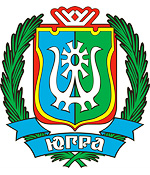
Khanty-Mansi okrug map, Russia
Khanty-mansi okrug latest news and posts from our blog:.
21 March, 2020 / Nizhnevartovsk - the view from above .
8 November, 2017 / Surgut - the view from above .
4 March, 2017 / Khanty-Mansiysk - the view from above .
12 February, 2016 / Khanty-Mansi Autonomous Okrug from above .
21 May, 2013 / The most powerful thermoelectric power station in Russia .
More posts..
History of Khanty-Mansi Autonomous Okrug - Yugra
Yugra is the historical homeland of the Ob-Ugric peoples: Khanty, Mansi, Nenets, and Selkup. They were engaged in hunting, fishing, cattle breeding. After the Turkic peoples pushed them from south to north, these peoples had to apply their skills in more severe conditions. It is at this new location Ugrians began to domesticate deer.
In the first half of the second millennium AD, the main features of the material and spiritual culture of Khanty, Mansi and forest Nenets were formed. It is believed that since then they have not undergone major changes. Since the second half of the 13th century, a new factor in the development of the region was its entry into the Golden Horde.
At the end of the 14th century, the collapse of the Golden Horde led to the emergence of a separate Tyumen Khanate. In 1495, the Siberian Khanate appeared. At that time the basic principles of political, administrative and socio-economic organization of this territory were developed. The region was called Ugra or Yugra.
More historical facts…
The region became part of Russia in the end of the 16th century. From the middle of the 18th century, this region became a place of exile for criminals. December 10, 1930, Ostyako-Vogul national okrug was formed with the center in the settlement of Samarovo. Construction of a new center began 5 km away from it. In February 1932, the new center of the region was named Ostyako-Vogulsk.
In 1934, the first steps to find oil and natural gas in the region were taken. October 23, 1940, Ostyko-Vogul national okrug was renamed Khanty-Mansi national okrug and Ostyko-Vogulsk was renamed Khanty-Mansiysk. August 14, 1944, the region became part of Tyumen Oblast. On January 27, 1950, Khanty-Mansiysk became a city.
On September 21, 1953, in Berezovo, the first natural gas in Western Siberia was produced. On June 23, 1960, the first oil in Western Siberia was discovered near Shaim. This was followed by the discovery of many other oil and natural gas fields. Along with the industrial exploitation of oil and gas fields, the timber industry developed rapidly.
By the end of the 20th century, under the influence of demographic and socio-economic developments the Khanty-Mansi region in fact lost its national basis. On July 25, 2003, Khanty-Mansi Autonomous Okrug was renamed Khanty-Mansi Autonomous Okrug - Yugra.
Khanty-Mansi Autonomous Okrug - Yugra views
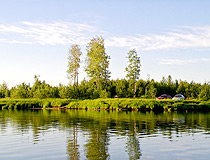
Rest on the lake in Yugra
Author: O.Frolov
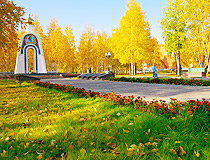
Golden autumn in the Khanty-Mansy region
Author: Leonid Karpushin
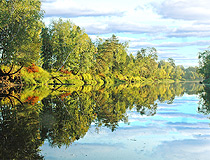
Beautiful nature of Yugra
Khanty-Mansi Autonomous Okrug - Yugra - Features
The name of the region is associated with the self-names of the two main groups of northern peoples - Khanty and Mansi. In the Middle Ages, the word “Yugra” was used to refer to peoples and lands beyond the Northern Urals.
This region, located in the middle of Russia, occupies the central part of the West Siberian Plain. Its territory stretches from west to east for almost 1,400 km, from north to south for 900 km. The area of the region is comparable to France or Ukraine.
The climate is temperate continental characterized by rapid change of weather especially in spring and autumn. Winters are long, snowy and cold with frosts below minus 30 degrees Celsius. Summers are short and warm. From the west this region is protected by the Ural mountains, from the north it is open to cold arctic air.
The highest points of the region are Mount Narodnaya (1,895 m) in the Polar Urals and Mount Pedy (1,010 m) in the Northern Urals. Two major rivers flow in Khanty-Mansi autonomous okrug: the Ob (3,650 km) and its tributary the Irtysh (3,580 km). About 30% of the territory is covered by swamps. There are more than 300,000 lakes surrounded by marshes and forests.
The largest cities of Khanty-Mansi Autonomous Okrug - Yugra are Surgut (396,000), Nizhnevartovsk (280,800), Nefteyugansk (128,700), Khanty-Mansiysk (106,000), Kogalym (69,200), Nyagan (58,500). Today, only about 32,000 people are representatives of indigenous peoples: Khanty, Mansi and Nenets. Half of them live in the traditional way.
This region is very rich in oil and natural gas. The largest oil and natural gas fields are Samotlorskoye, Fedorovskoye, Mamontovskoye, Priobskoye. There are also deposits of gold, coal, iron ore, copper, zinc, lead and other mineral resources.
The climate is not favorable for agriculture. Most of the agricultural products and foodstuffs is brought from other Russian regions. Waterways and railways are the main shipping ways. The total length of the pipeline network is 107,000 km.
About 60% of Russian oil is produced in Khanty-Mansi Autonomous Okrug - Yugra. In total, more than 10 billion tons of oil were produced here. The total number of oil and natural gas fields discovered is 475. In the coming decades, the Khanty-Mansi region will remain the main resource base of hydrocarbons in Russia.
Tourism in Khanty-Mansi Autonomous Okrug - Yugra
Yugra has unique natural, cultural and historical resources for the development of recreation and tourism. On the territory of the region there are historical and cultural monuments, as well as modern infrastructure for lovers of cultural, educational, recreational tourism, and outdoor activities. International events (sports competitions, festivals and forums) help to open this place to foreigners as an amazing corner of the globe.
Khanty-Mansi Autonomous Okrug - Yugra has a number of wonderful natural sites worthy of attention: two nature reserves (“Malaya Sosva” and “Yugansky”), four nature parks (“Samarovsky Chugas”, “Siberian ridges”, “Numto”, “Kondinskie lakes”), ten monuments of nature, archeological complexes (“Barsova Mountain”, “Saygatino”, Sherkaly settlement).
Holidays of the northern peoples are also popular among tourists: Reindeer Herder’s Day, Day of indigenous Peoples of the North “Crow day”, Fisherman’s Day, Bear holiday and others.
Active and extreme types of tourism (skiing, snowboarding, kiting) are gaining in popularity. There are seven ski resorts in the region. In summer, travelers can go rafting on mountain rivers of Siberia. Tourists can also go on a special oil tour that includes a visit to the oil-producing companies. They learn about the oil industry and the history of oil exploration in Siberia.
Khanty-Mansi Autonomous Okrug - Yugra is a region of endless charm of the beautiful nature and modern tourist facilities. True lovers of northern landscapes and local cultures will be able to fully enjoy the incomparable scenery and generous hospitality in Ugra.
Khanty-Mansi okrug of Russia photos
Khanty-mansi autonomous okrug scenery.
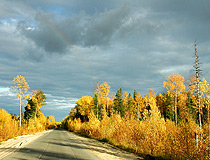
Road through autumn forest in Khanty-Mansi Autonomous Okrug
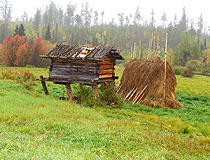
Deep winter snow is not a problem in Khanty-Mansi Autonomous Okrug
Author: Chernenko
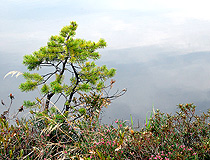
Yugra scenery
Author: Sergej Fedotov
Pictures of Khanty-Mansi Autonomous Okrug - Yugra
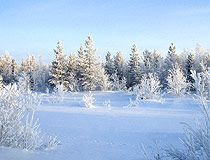
Winter in Khanty-Mansi Autonomous Okrug
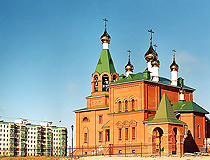
Orthodox church in Khanty-Mansi Autonomous Okrug
Author: Alexey Borodko
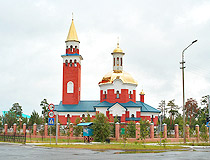
Church in Khanty-Mansi Autonomous Okrug
Author: Peter Sobolev
- Currently 2.80/5
Rating: 2.8 /5 (189 votes cast)
- Bahasa Indonesia
- Slovenščina
- Science & Tech
- Russian Kitchen
Khanty-Mansiysk: Why you simply must visit this northern land of mammoths
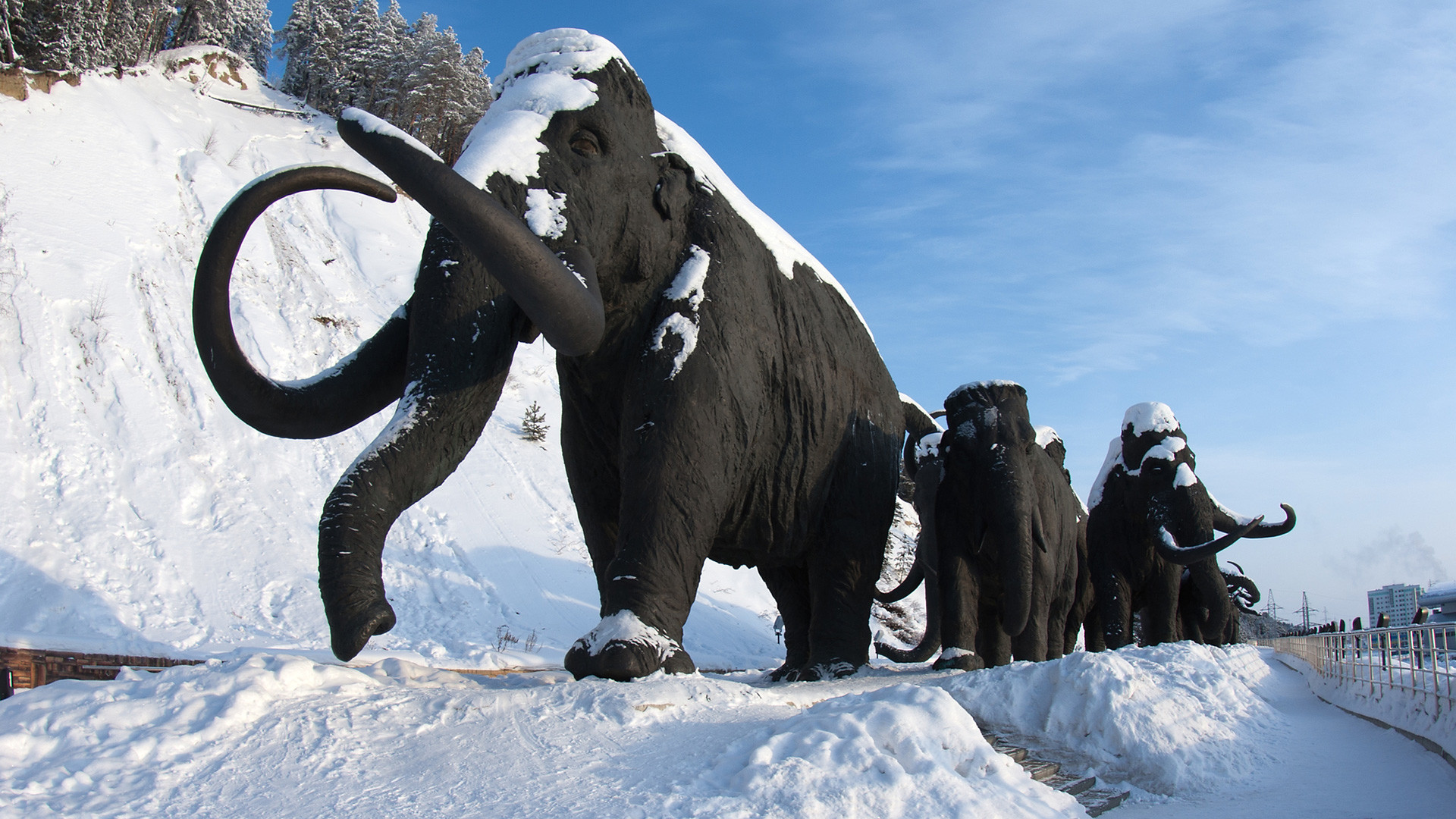
“I have been to Yugra many times. I was sworn in as a Siberian in a cedar forest,” producer Andrey Suleikov writes in the preface to a collection of legends called Yugra. It’s My Land . “I tasted lingonberries in the cold and could not tell whether the berries were coated in sugar or ice. I also enjoyed outdoor hot springs while taking a traditional Siberian bath."

Fuel pumping stations
Sounds more like time travel than a present-day tourist trip, doesn’t it? But that is what Yugra is like: a fusion between prehistoric things like mammoths and modernity, which has brought oil, gas and new buildings. Even the region’s official name (which is quite long: the Khanty-Mansi Autonomous Area – Yugra) combines the present with the past.
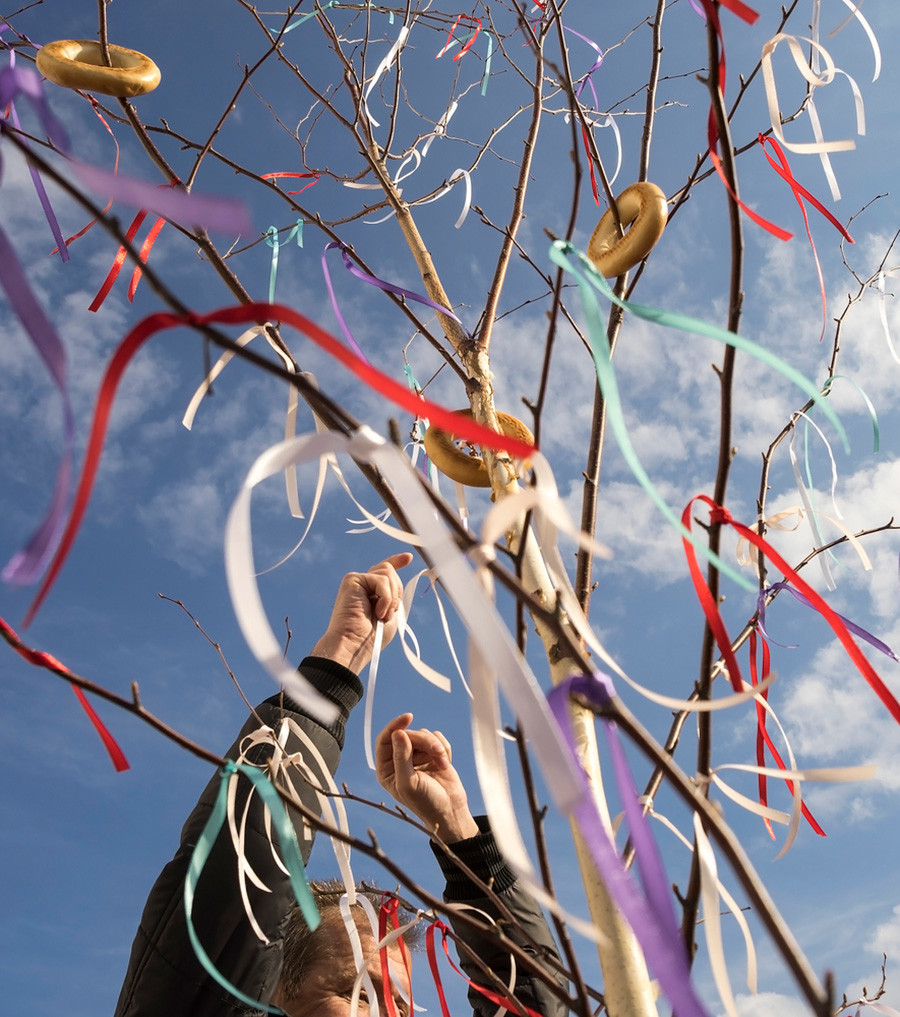
Tying a ribbon is a national tradition
There is a beautiful legend about Yugra’s origins. In one very bright, warm and sunny city, twins of unprecedented beauty were born: a brother named Yug and a sister named Ra. At first, they grew up like ordinary small children, but with age they began to argue and fight, so much so that when they did flames flared up around them. The townspeople were afraid that they would burn everything down, so they exiled Yug and Ra to a remote northern land covered with ice and snow. The brother and sister illuminated this land with their light and made it warm so that people could come here to live. Yug and Ra stopped fighting and began living together in harmony. Since then, this northern land has been called Yugra.
When you look at the map, it may seem that Khanty-Mansiysk is located almost in the middle of Russia. However, the climate here is similar to regions of the Far North. In winter, the temperature here drops to below -40 degrees Celsius.
We asked local residents and people who know this region well to tell us more about it and to share some tips for tourists who come to visit.
Why should a foreigner visit Khanty-Mansiysk?
“If you want to feel the coldness and colors of Russian winter, then you should definitely stop by in our small cozy town,” says a local tattoo artist, Semyon Chepurnoy.
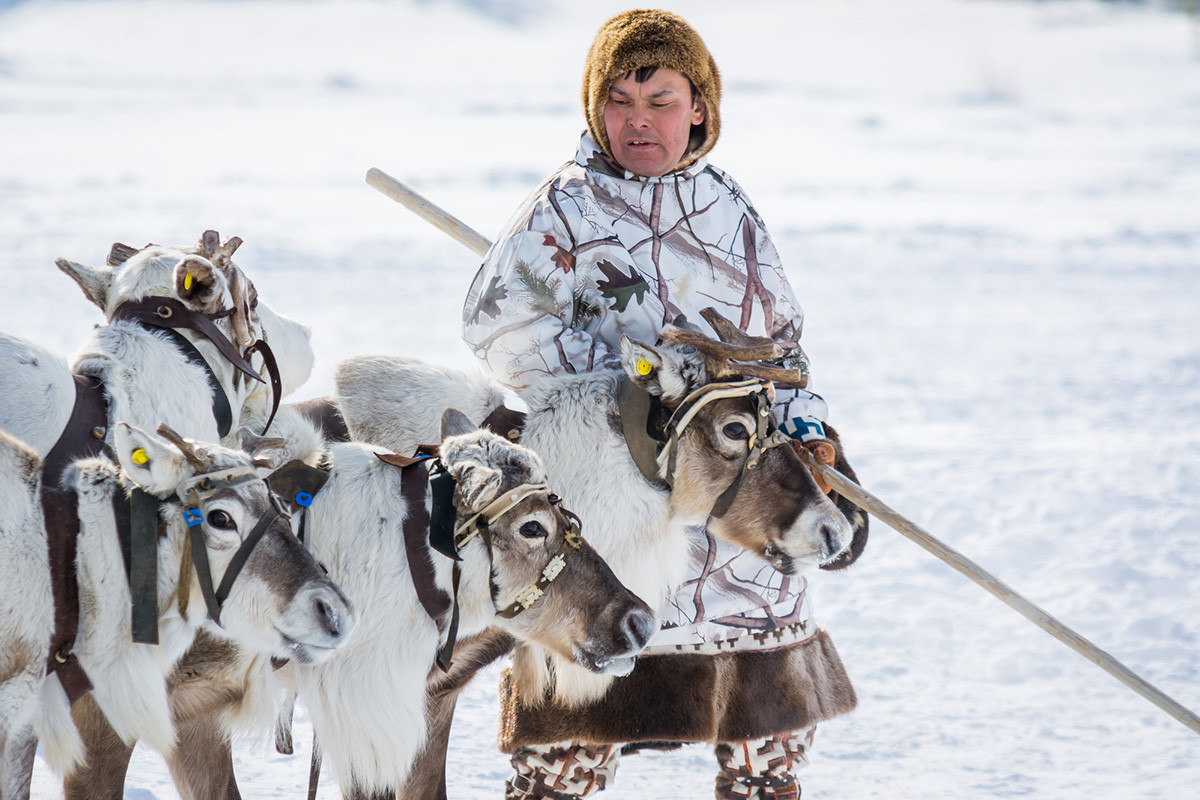
A Khanty man in a traditional dress
Yevgeny Zinovyev, a journalist and the former editor-in-chief of a local media outlet, says that Khanty-Mansiysk provides the opportunity to experience a real and not touristy part of Russia. “In winter, there are frosts, snowdrifts and wind. In summer, heat, midges and bears. At any time of the year, you can experience the everyday life and customs of the indigenous peoples: the Khanty and Mansi. And of course, in Khanty-Mansiysk you can get to know the backbone of modern Russia – its oil and gas sector."
“We have unique scenery here. Khanty-Mansiysk is located on seven hills and is surrounded by the taiga. There are a lot of fish in the rivers, and a lot of mushrooms, berries and pine nuts in the forests surrounding the city,” says local insurance company employee Sergey Yankovich.

View of the city and the Irtysh River
The harsh climate of the region influences how local residents relate to visitors. “Residents of the city are very good-natured and welcoming and are always ready to offer help in any situation, even to a stranger, because in the north, there is an unspoken rule: If you see that a person is in distress, be sure to help them, because tomorrow, it may be you in their place. The harsh climate and surrounding scenery leave no room for error, especially in winter,” Sergey says.
Things to see/do/taste in Khanty-Mansiysk
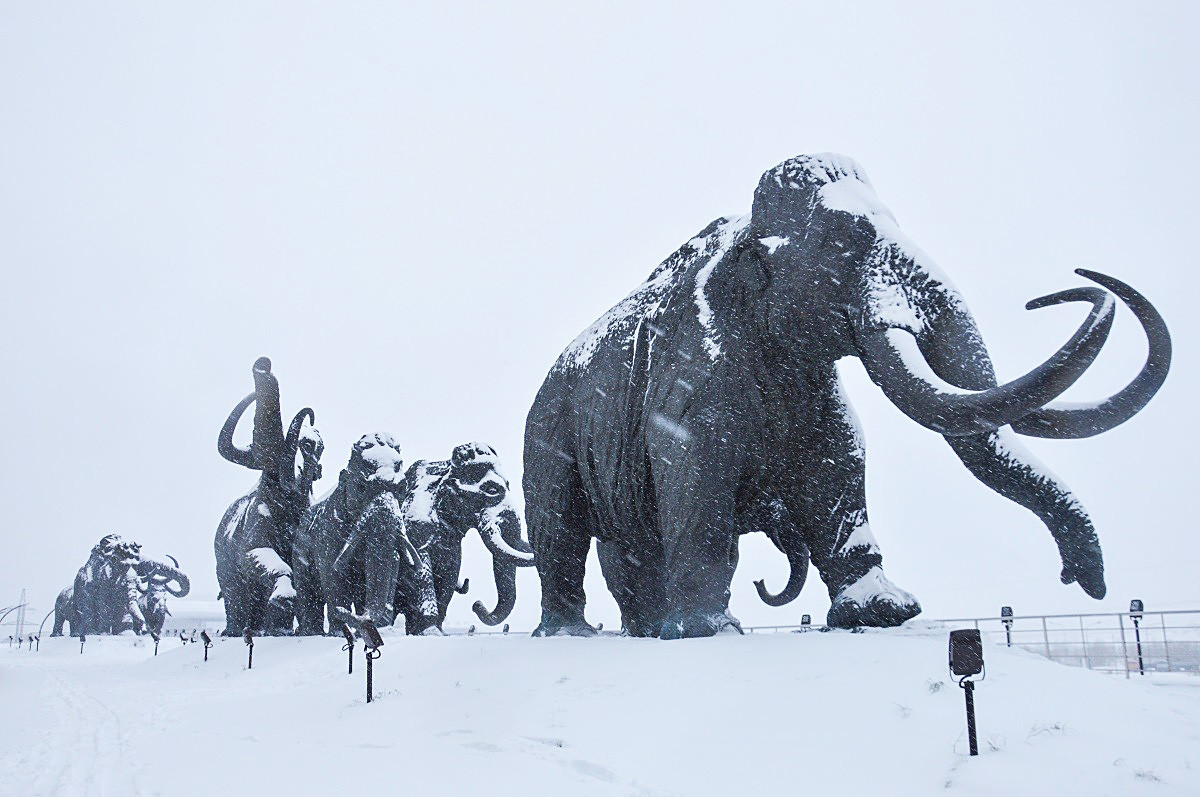
Mammoths at the Archeopark
According to Irina Pudova, a local resident and the author of a collection of legends called Yugra: It’s My land , the first thing to do in Khanty-Mansiysk is to see the local mammoths. Seven life-size bronze prehistoric animals "roam" the area near Samarovsky Hill on the grounds of the Archeopark complex. Here you will also find a prehistoric bison, a pack of wolves, a cave bear, two woolly rhinos and prehistoric people themselves.
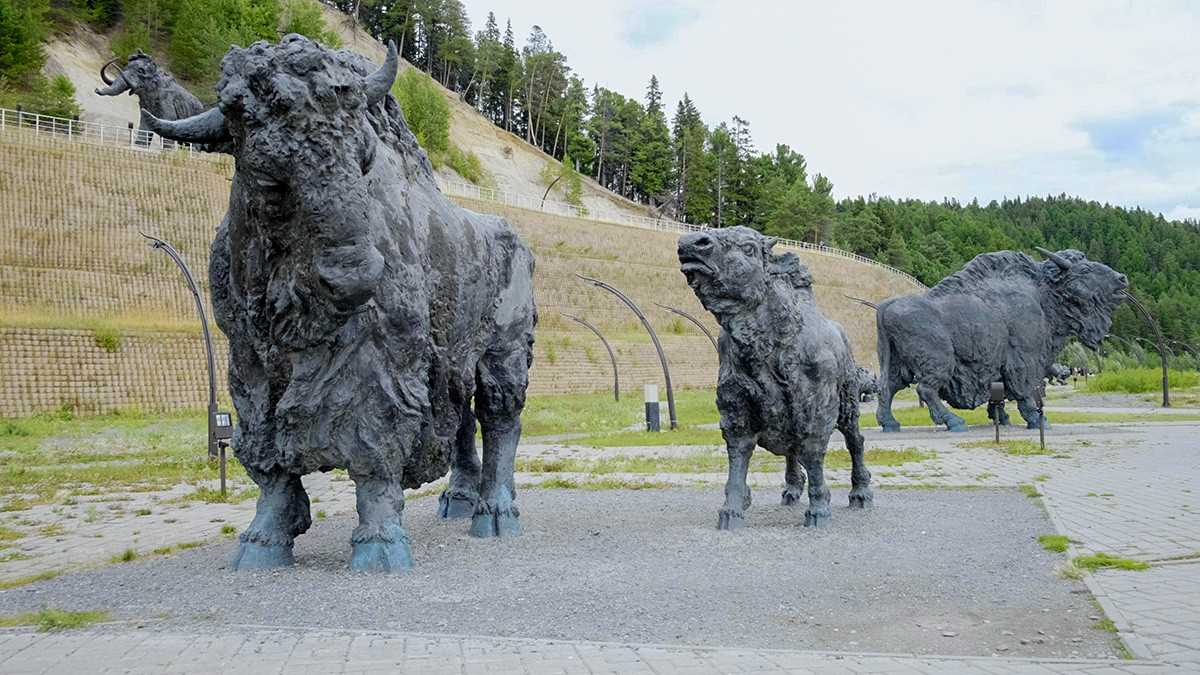
Sculptures of bisons at the Archeopark cultural and tourist complex
“Then you could get something to eat,” Irina advises. “The thing to do is to go to any local restaurant of Siberian cuisine and ask for muksun. It is a valuable freshwater fish of the salmon family, which is highly prized by locals and tourists alike.”
Khanty-Mansiysk is a relatively new city and only received this status in 1950. Soo oil was discovered in the region, prompting a dramatic push in its development. Prior to that, there were just Siberian settlements built by Russia in the late 16th century. Irina is impressed that a modern city was built in such harsh conditions.
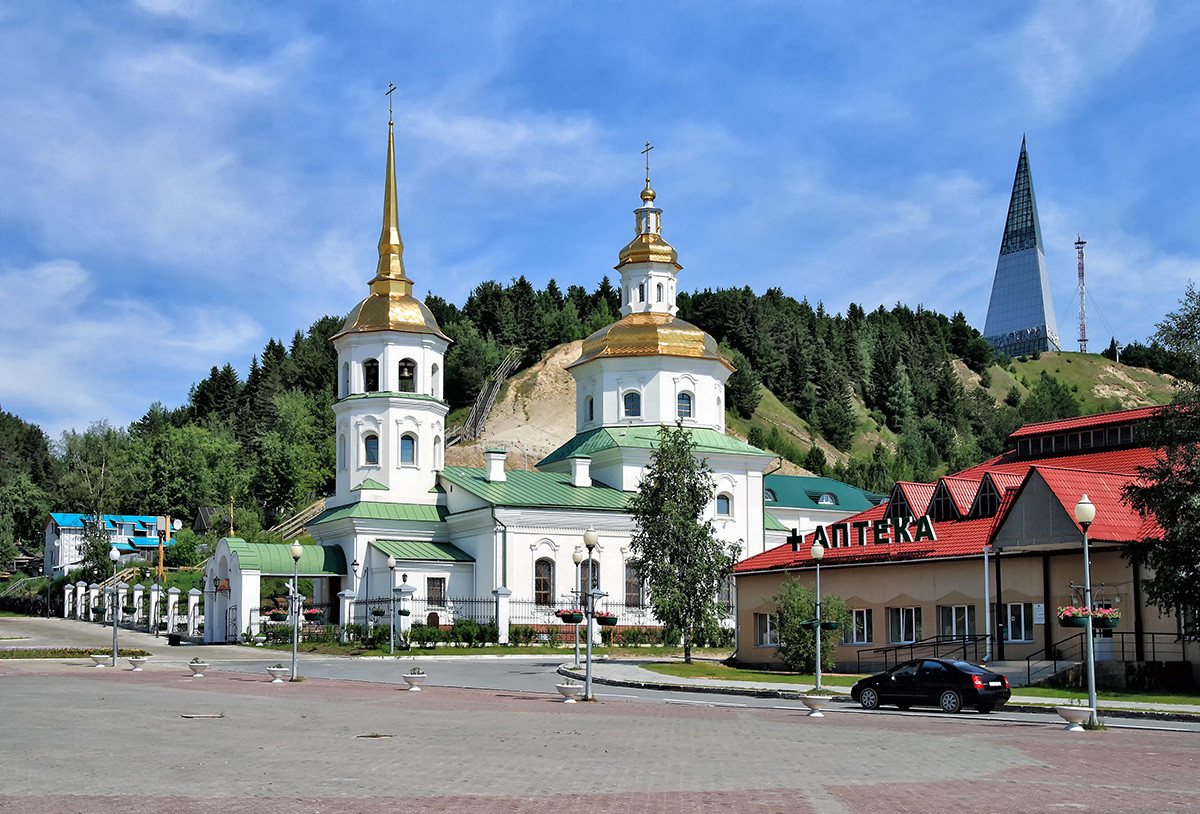
The Church of the Protection of the Holy Virgin
“Cultural objects, squares, houses - all this is unique. And everything is new, there is nothing very ancient here. Except for mammoths!” she says.
In addition to the Archeopark mentioned above, Yevgeny Zinovyev’s list of favorite places in the city includes the Museum of Geology, Oil and Gas, along with the Museum of Nature and Man and the centuries-old cedars in the Samarovsky Chugas natural park. He recommends checking out the views from the observation deck near the Monument to the Explorers of the Yugra Land and paying a visit to a local bathhouse.
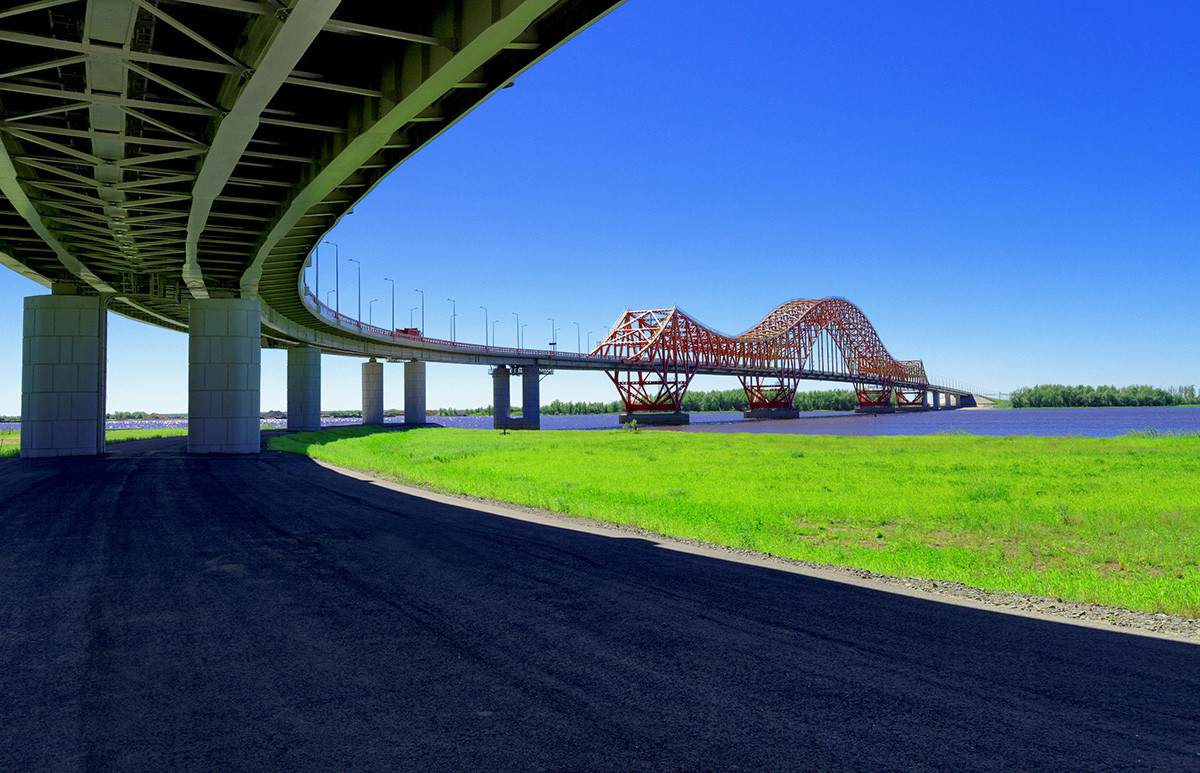
'Red Dragon' bridge over the Irtysh River
Yevgeny also provided us a checklist of culinary delights that anyone visiting Khanty-Mansiysk should be sure to try:
- Muksun (in any form but best of all frozen and sliced as Stroganina).
- Wild berries (cranberry, cowberry, cloudberry).
- Venison (in any form but best of all stewed and sprinkled with frozen berries and pine nuts).
Sergey Yankovich recommends visiting the open-air ethnographic museum Torum Maa, which means "Sacred Land" in Mansi. “There you can get acquainted with the history of the city and the district, as well as with the life of the indigenous peoples of the Khanty and Mansi, who belong to the Finno-Ugric group,” Sergey says.

Torum Maa ethnic center
In addition, he advises anyone who comes to Khanty-Mansiysk to visit the spot where the Ob and Irtysh rivers meet, pay a visit to Misne Hotel’s restaurant and taste traditional dishes there, as well as dishes prepared by local fishermen and hunters while in the taiga.
According to Semyon Chepurnoy, the Valley of Streams natural park is another must for any visitor. It is one of local residents’ favorite recreation areas, where you can stroll along a dedicated footpath offering stunning views of the city. Semyon also advises trying pancakes at the GoodFood chain of cafes.
What are the best souvenirs?
“We all love something mystical and supernatural. There is a strong culture of shamanism here, so I think it’s cool to take with you some local amulets charged by a shaman—a bear claw or a pendant made of beads and deerskin,” says Irina Pudova.
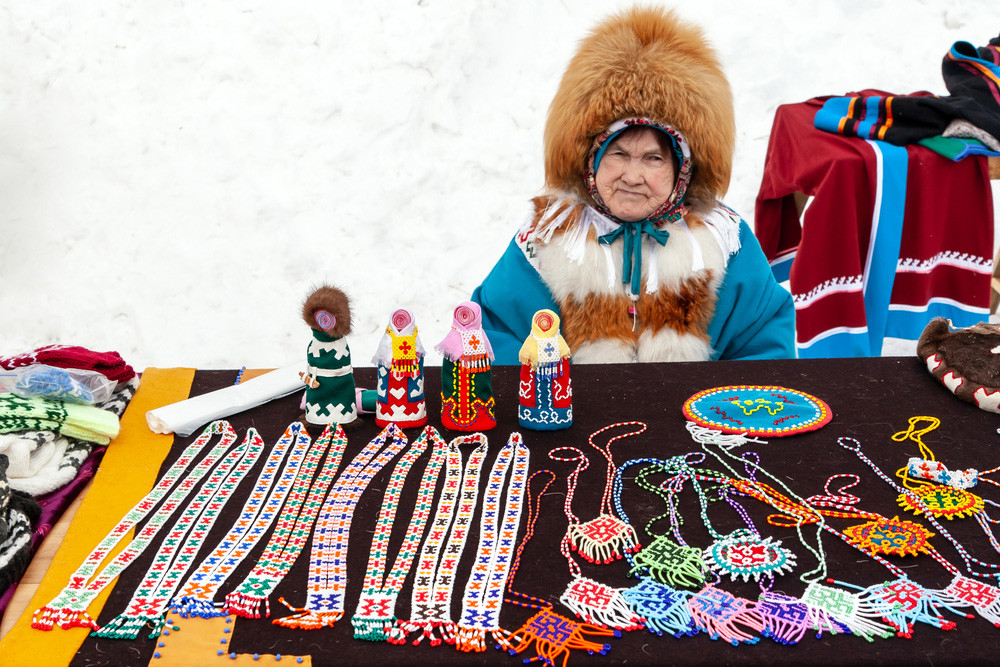
A Khanty woman in the traditional dress selling souvenirs
Sergey Yankovich advises that authentic souvenirs can be found at the Crafts Center on Roznina Street. “There you can also see and even try on the national costumes of the Khanty and Mansi and try to solve traditional puzzles that representatives of the indigenous peoples made for their children.”
According to Yevgeny Zinovyev, the best souvenirs are Khanty and Mansi amulets, clothes, jewelry, as well as traditional local treats such as muksun, wild berries, pine nuts and venison.
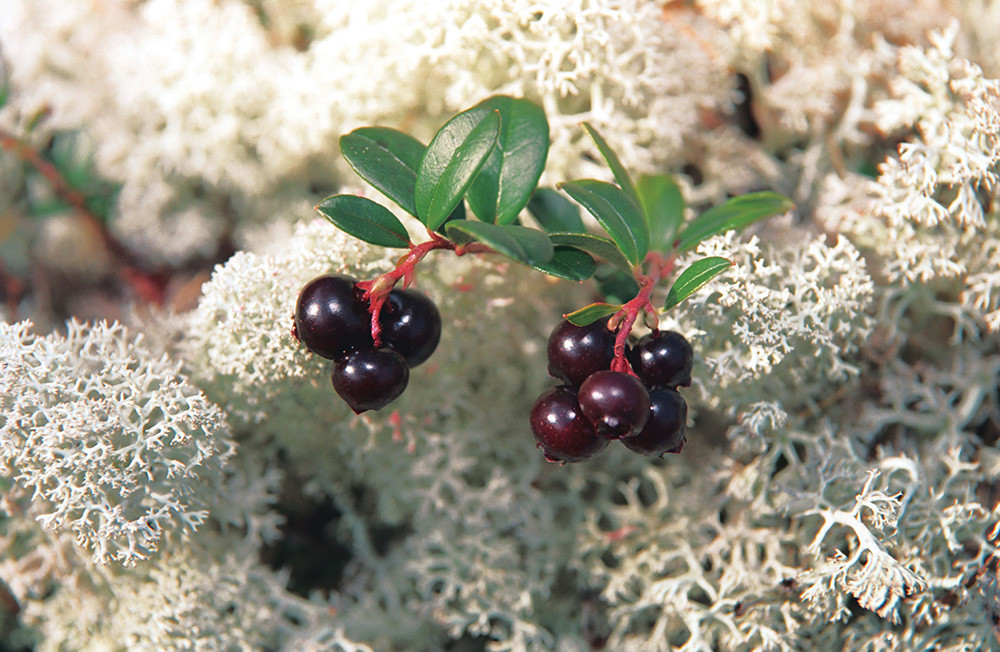
Cowberry bush
For his part, Semyon Chepurnoy recommends bringing away memories and photographs as well as a little bit of Siberian Frost ❄.
If using any of Russia Beyond's content, partly or in full, always provide an active hyperlink to the original material.
to our newsletter!
Get the week's best stories straight to your inbox
- 10 main stops on the Trans-Siberian Railway
- Naryan-Mar: Why you should visit this remote Arctic city
- An expat’s confession: Why I miss the city by the Amur – Khabarovsk
This website uses cookies. Click here to find out more.

IMAGES
VIDEO
COMMENTS
Overwhelming crowds of visitors have stirred anti-tourism sentiments in Barcelona, Spain. Following several years of pandemic-induced downturn, the travel sector is not only back, it's ...
Tourism crises are important events affecting the development of destinations. However, the academic community lacks adequate knowledge from the accumulated literature on the classification attributes, spatial distribution, and impact structure of global tourism crises.
The destinations that want tourists to stay away. 1. Amsterdam. Photograph: hurricanehank / Shutterstock.com. Amsterdam 's reputation as an anything-goes hub of hedonism is well known, and the ...
The guidelines were produced in consultation with the Global Tourism Crisis Committee and aim to support governments and private sector to recover from an unparalleled crisis. Depending on when travel restrictions are lifted, the United Nations specialized agency warns that international tourist arrivals could fall by between 60% and 80%.
However, WTTC indicates the total contribution from travel and tourism accounts for around 16.8 million jobs. The US has the world's highest Covid-19 death rate, according to data from Johns ...
UN Tourism and COVID-19. As the world is facing an unprecedented global health, social and economic emergency with the COVID-19 pandemic, travel and tourism is among the most affected sectors with airplanes on the ground, hotels closed and travel restrictions put in place in virtually all countries around the world. Therefore, UN Tourism has launched a new dashboard on COVID-19 and tourism ...
Tourism is the economic sector that has been hardest hit by COVID-19 and all participants accepted an invitation from the UNWTO Secretary-General to become part of a Global Tourism Crisis Committee, formed as UNWTO prepares to launch a global guide for recovery. The UNWTO-led Committee will hold regular virtual meetings, reflecting the need for ...
The October World Economic Outlook projected the global economy would contract by 4.4 percent in 2020. The shock in tourism-dependent economies will be far worse. Real GDP among African countries dependent on tourism will shrink by 12 percent. Among tourism-dependent Caribbean nations, the decline will also reach 12 percent.
Tourism crisis management is an important field with great future ... such as the impact of the tourism crisis on tourism destinations and tourism 17, 18 or gender differences in tourism risk ...
As of 6 April 2020, 96% of all worldwide destinations had introduced travel restrictions in response to the pandemic. There is little doubt that tourism was the most affected of all sectors, with businesses, and livelihoods around the world severely impacted. ... Tourism: From Crisis to Transformation. UNWTO andthe COVID-19 Crisis, preliminary ...
Reduced Ecotourism Is Taking a Toll on Nature. According to a study commissioned by High Level Panel for A Sustainable Ocean Economy, small island states have seen a 24 percent decline in tourism revenue since the start of 2020. The report also cites that in the Bahamas and Palau, the gross domestic product (GDP) is poised to shrink by at least ...
Destination Management During a Crisis. With over one billion people traveling internationally each year and with one out of every 11 jobs supported by tourism, the industry is arguably one of the most complex and far-reaching economic and social ecosystems in the world. Therefore, national and international crises can have huge negative ...
Given the global impact of COVID-19 (SARS-CoV-2) on the tourism industry, crisis management has once again become a hot topic for research. This article reviews the state of the art in the existing literature on crisis management frameworks in tourism and hospitality through a meta-analysis approach. A total of 36 articles published in peer-reviewed journals between January 2000 and December ...
The tourism sector creates around a tenth of the greenhouse gas emissions that are driving the climate crisis, according to the World Travel & Tourism Council. Practically half of all transport emissions stem from global tourism, other studies say. And total emissions from tourism are forecast to rise by a quarter between 2016 and 2030, says ...
for crisis preparedness at U.S. tourist destinations to reduce business interruptions and improve the destination's image of safety. Background of the Problem Many destinations rely on tourism for growth and existence (Ritchie, 2004). The reliance on tourism increases the responsibility of destination managers to consider the
crisis is particularly interesting, as it is o ne of the world's first cases in w hich. the Internet played a major role in the mana gement of destination mar keting. during and after a tourism ...
The September 11, 2001 terrorist attack against the USA impacted on airlines and tourist destinations worldwide, as did subsequent attacks on tourists. These events highlight the importance of destination crisis management for the global tourism industry. Experienced tourism marketer and trainer, David Beirman, has created a guide to crisis ...
Crisis management is therefore a strategic. problem which should be managed adequately by all tourist destinations: their quality. and sustainability depends on the recognition that safety (risk ...
For tourism crises, social media present a double-edged sword: while disseminating the damage caused by tourism crises, it also has the potential to enhance the destination's visibility and serve as a promotional tool. So, we cannot entirely negate the dissemination of tourism crises but rather proactively utilize its positive aspects to promote the sustainable development of the tourism ...
By analyzing this data, we can better understand Mykonos as a tourism destination today - and debunk a few myths. Let's break it down. By plane. In 2023, more people flew directly to Mykonos from abroad than in 2019, but slightly fewer than in 2022. International arrivals in the first half of 2024 were down 5% from 2023.
Khanty-Mansi Autonomous Okrug — Yugra [a], commonly shortened to Khantia-Mansia, is a federal subject of Russia (an autonomous okrug of Tyumen Oblast).It has a population of 1,532,243 as of the 2010 Census. [4] Its administrative center is located at Khanty-Mansiysk.. The peoples native to the region are the Khanty and the Mansi, known collectively as Ob-Ugric peoples, but today the two ...
The largest cities are Surgut, Nizhnevartovsk, and Nefteyugansk. As of the early 2010s, about 51 percent of the oil produced in Russia and 7.3 percent of the world's supply came from Khanty-Mansi Autonomous Okrug, making the region very important economically. More than 10 billion tons of oil has been was recovered from the okrug's fields ...
Tourism in Khanty-Mansi Autonomous Okrug - Yugra. Yugra has unique natural, cultural and historical resources for the development of recreation and tourism. On the territory of the region there are historical and cultural monuments, as well as modern infrastructure for lovers of cultural, educational, recreational tourism, and outdoor activities.
According to Irina Pudova, a local resident and the author of a collection of legends called Yugra: It's My land, the first thing to do in Khanty-Mansiysk is to see the local mammoths. Seven ...